1. Title slide
Presentation Version Date, March 23, 2019
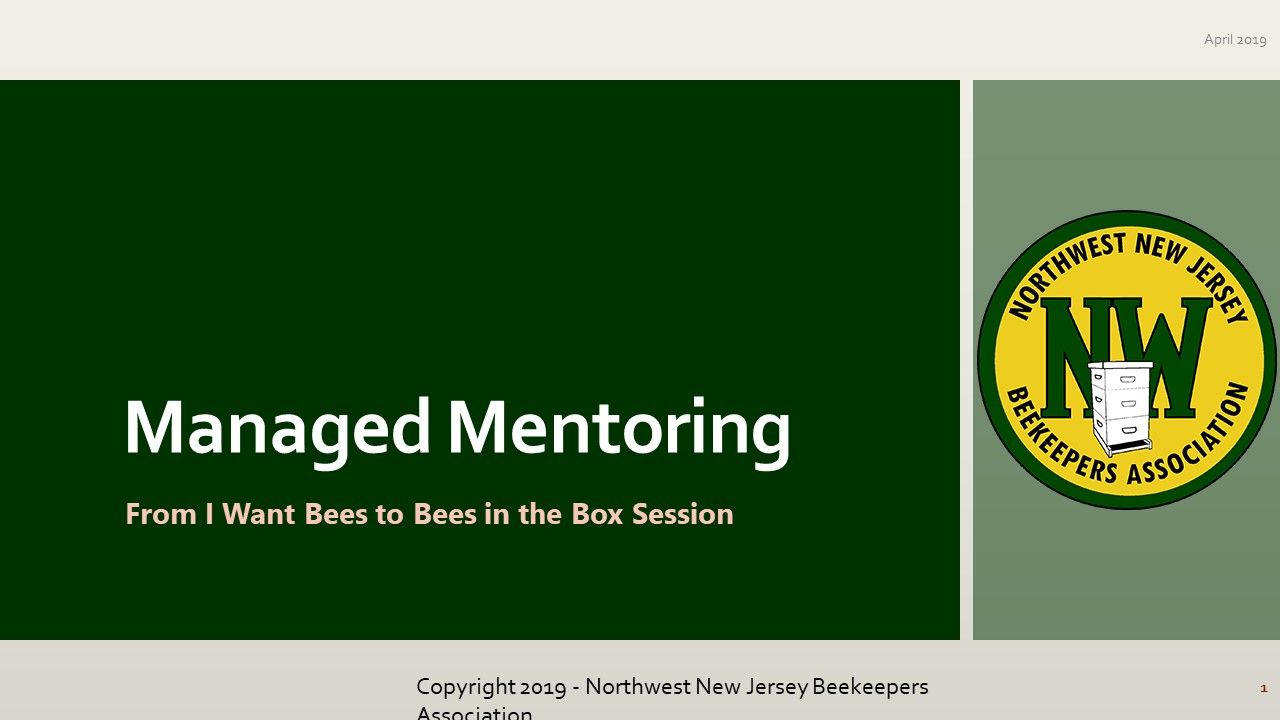
NWNJBA Managed Mentoring Program
I want to keep bees - to - Bees in the box
I want to keep bees - to - Bees in the box >
For this part of the program, we want to help you get prepared. Thinking about the activities here, you will want to get things in order by securing bees, buying and prepping your equipment, picking and preparing where you will place your bees, and other odds and ends that will take care of all of the activities that you need to be fully ready when your bees arrive.
How to use this module
FOR THIS MODULE, you can
- Watch the presentation: For Part 1, starting out, mentor Kevin Inglin walks through the timeline of getting started and prepared.
- Review the refresher slide notes: Look at each of the slides and read the prepared notes and guidance that accompany each slide. This allows you to jump back to a topic quickly. You can also find the time in the presentation when this material was covered.
- Review the CHECKLIST: For each of our modules we will provide a checklist
- Access the module RESOURCES: When there are module resources, we will present them for download.
Note: These resources are presented as a supplement for after you one participates in the Part 1 session.
- They are also for our program participants who missed a session and want to get caught up on what they missed.
- If you are planning to attend an upcoming session, feel free to browse it to get a sense of what you will see but be assured we will go over with you in the presentation.
If you are just starting out....we recommend you attend the session and formally join the program, but if you are not able to do that feel free to use these resources in any what that they help you.
Recorded March 23rd, 2019 - Hunterdon County Library, Flemington NJ
I Want Bees
To Bees in the Box
Presenter: Kevin Inglin
Each of the Content Slides are below with accompanying notes
Note: Title and Section slides will be included in order to give sense of the organization of the content.
They will not have instructional notes so they will be respresented in a thumbnail format.
Video Timing: Each of the slides will have a note as to when in the presentation the topic was covered.
The notes are summary in nature next to the slide descriptions. To get a full sense of the topic and what was shared
we encourage you to view the video.
Presentation Version Date, March 23, 2019

Overview of the contents of this presentation and what it covered
Notes that it is the first of many related sessions.
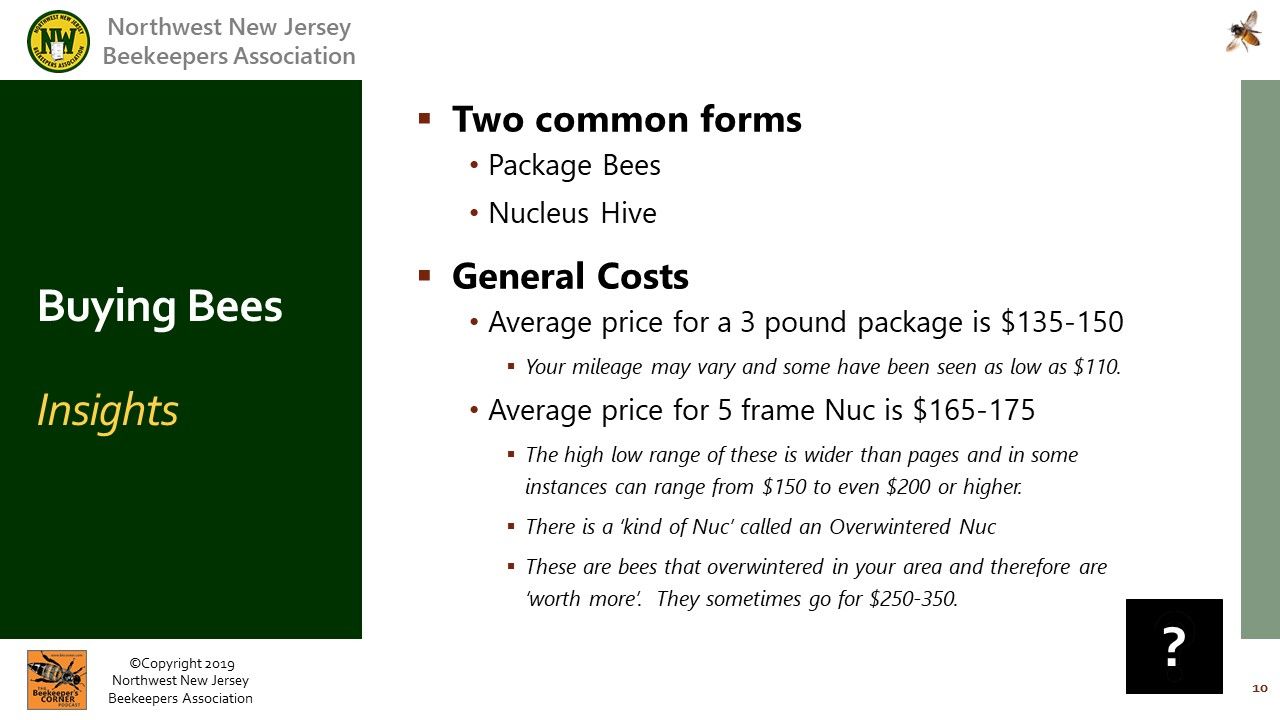
Agenda of the session
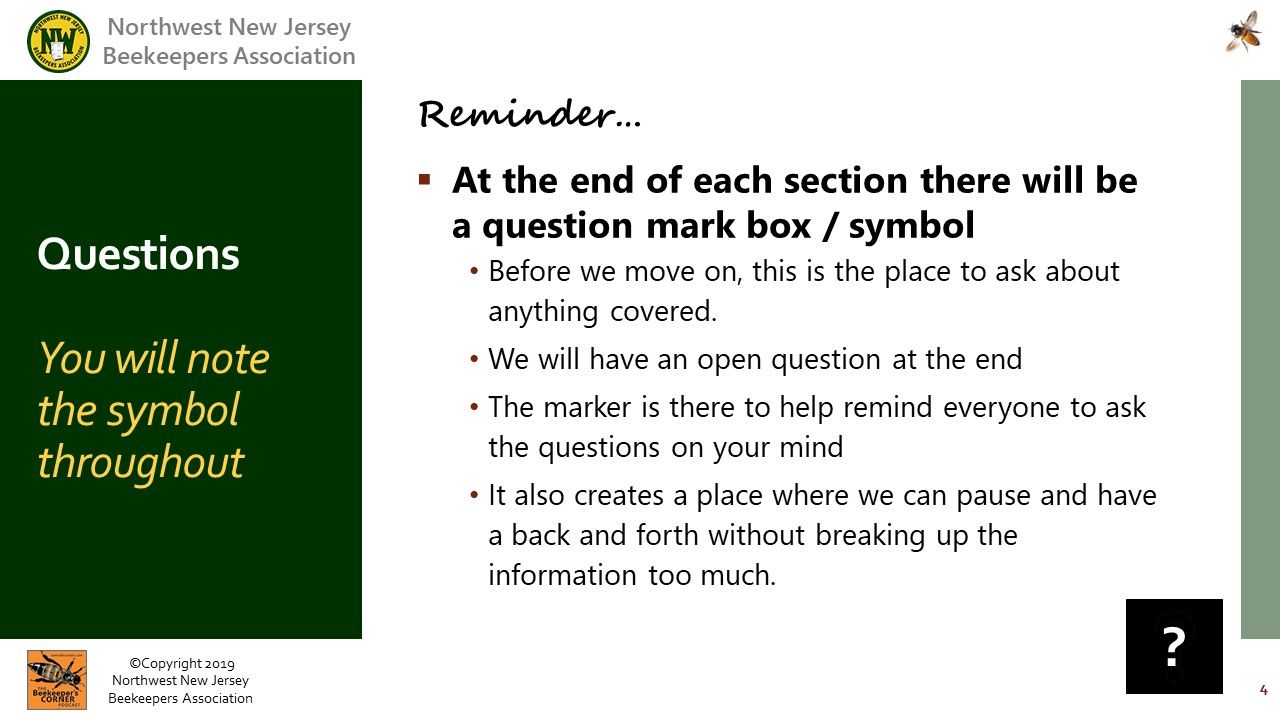
Slide that informs how we handled questions during the presentation

: Overview of the content in the presentation
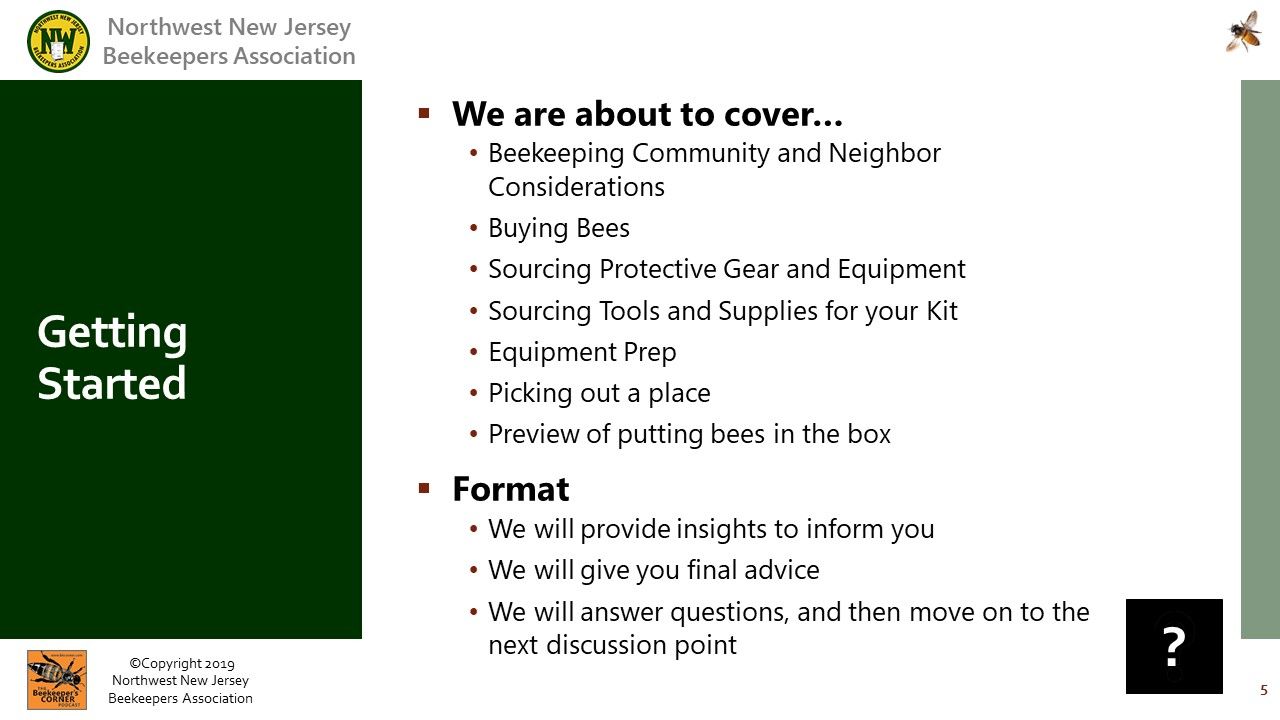
Video Timing: 2:50
Ideas of being a good Neighbor while keeping bees and following recommended guidelines.

Video Timing: 2:55
: Judge the prospect of neighbor conflict. If it is not in good standing, bees will not improve the situation.
: If you have a large property, you can take measures to mitigate any possible encounters with others.
: If the situation is forced, consider placing your bees elsewhere.
: Follow the guidelines, they will help you if ever there is a problem. See the resources below to get a copy of them.
: Do not keep more bees than you can manage.
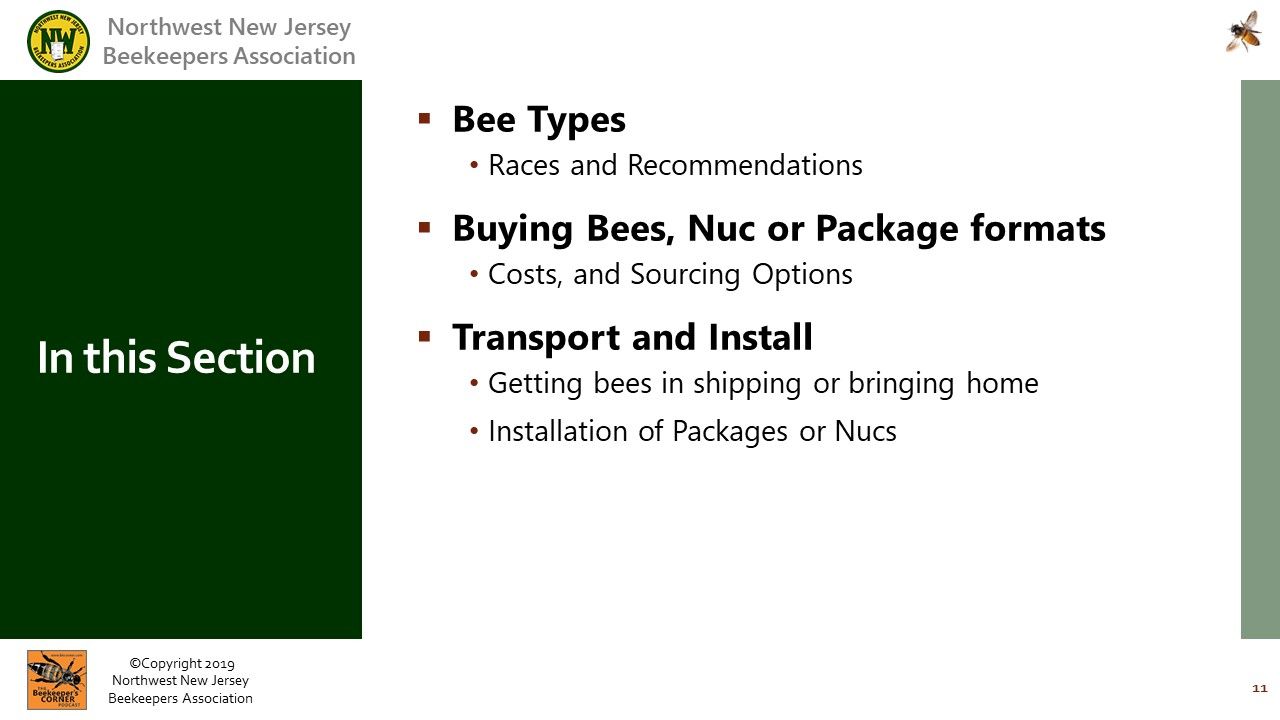
Video Timing: 5:04
: We want you to start with two hives, vs. one.
: Do not go forward with more than two as a new beekeeper. Get good at it first, then grow.
: Plan to manage your bees. Follow our plan, and do not be a beekeeper that simply has bees in the yard.
: Bees are livestock, not lawn ornaments and as such they require a long term commitment to manage them.

Video Timing: 7:44
Types of bees, sourcing bees, handling bees.
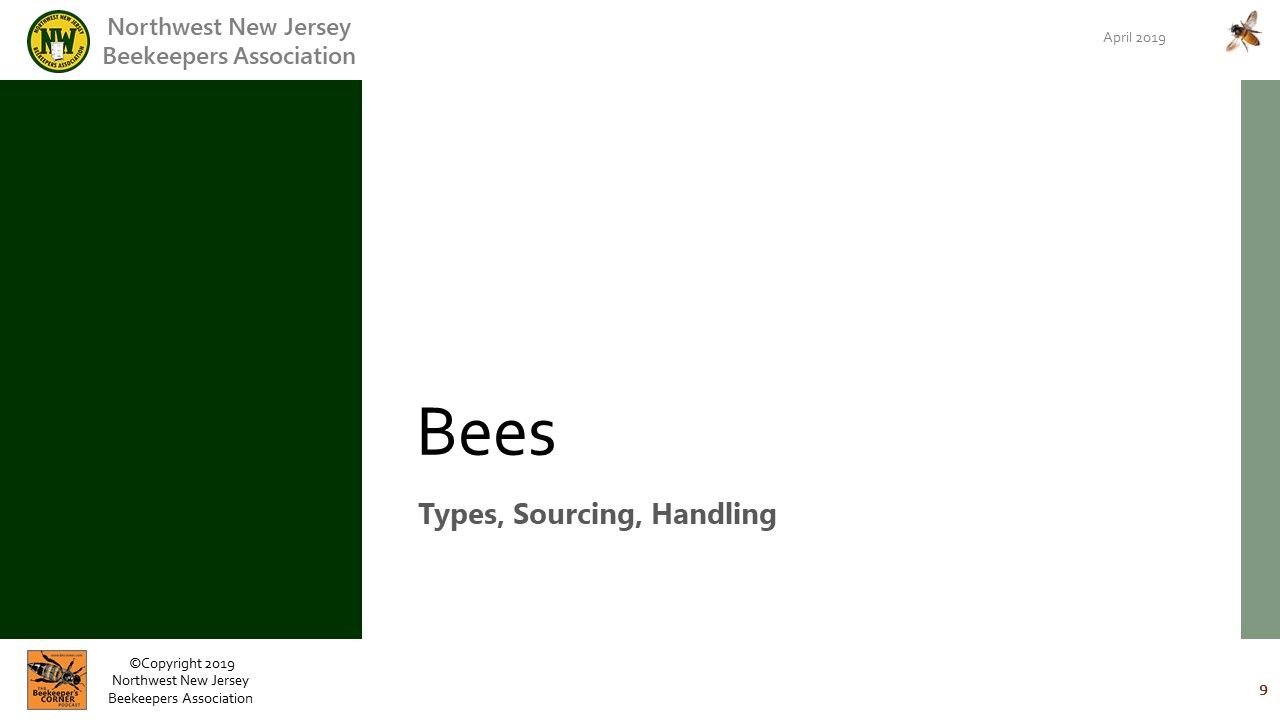
Video Timing: 7:55
: Whether you choose a package or nucleus (nuc) is a personal preference. Packages cost less, nuc hives start faster and are already established.
Note: See terms below
: Buying bees that were raised here is a better option if you can get them. They have better acclimitization to our climate and zone.

Package Bees: A package of bees is a common format for bees for sale. Bees will come in a wooden box that has screened sides. It includes 3 pounds of bees (literally by weight), a queen, and some food to keep them viable during transportation. You 'shake' the package of bees into your starter hive on frames with foundation starters and they build a nest and colony from scratch.
Nucleus (aka Nuc): A nuc hive is a full sized colony in miniture. It is a half sized box that includes five frames with drawn out comb, bees, and a queen. The hive is fully operational and can be transferred into a standard box and will begin to expand to a typical larger colony of bees.
Video Timing: 12:00
The video on this topic area expands the understanding and advice.
- the notes that are accompanying these slides are summary in nature.

Video Timing: 14:19
: Yes there are different kinds of bees, but most major suppliers have quality bees. Do not fret over some special variety. While there are benefits, more impetus should be on keeping bees well.
: The reputable bee suppliers are focusing on good genetic queens just like the specialty bee suppliers.

Video Timing: 15:19
: Orders for sourcing bees occur in the winter. This is especially true if you want something special.
: Bee suppliers have a quota and if you wait too long you may not be able to secure an order. Dec/Jan is not too early to place an order.
: Buy bees from established, veteran suppliers, avoid new sellers if you are new
: If you want to buy specific brands of bees, plan ahead and get your order in early.
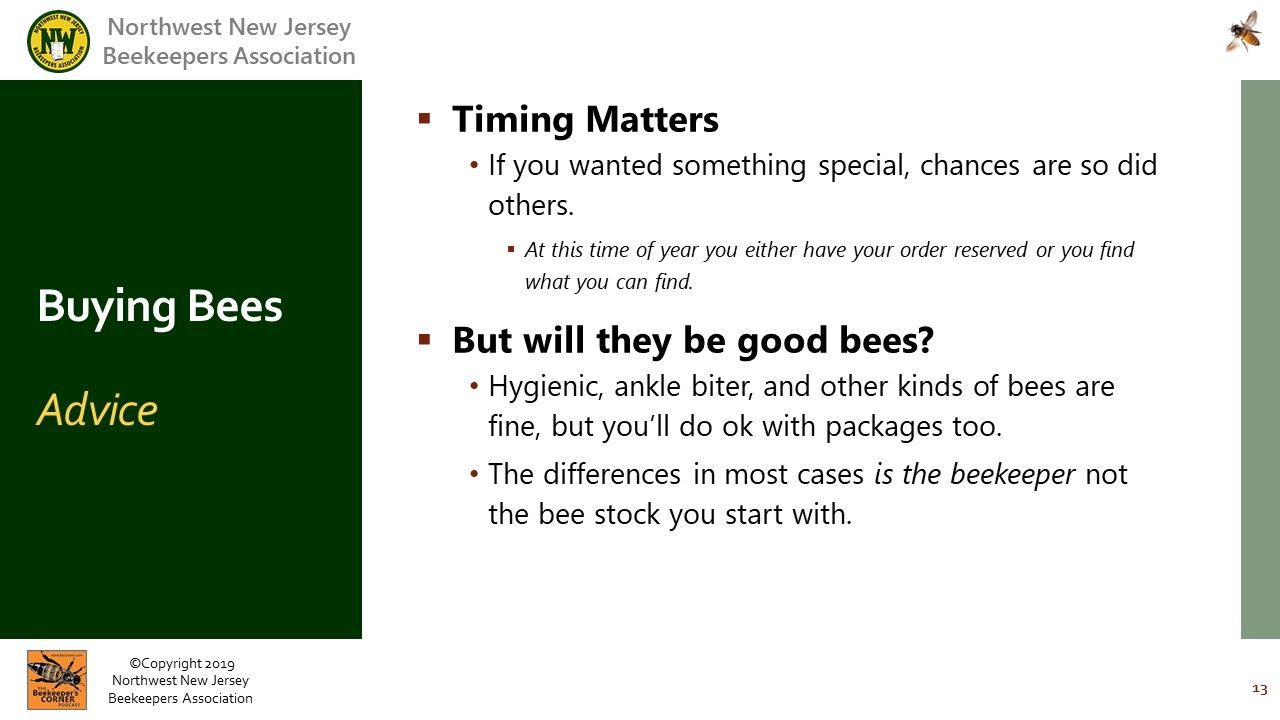
Video Timing: 16:02
: We recommend you visit www.njbeekeepers.org and go to the hive and honey products page to find suppliers for bees.
: Buy from a reputable source. Inquire with us about options of who is reputable at a meeting.
: Buy bees from established, veteran suppliers, and avoid new sellers if you are new and cannot tell if bees are in good shape when you purchase them.
: Nucs get going faster but cost more. Packages are take longer to get going but are suitable for building out to a full colony for overwintering.
: Pay more to have your queen marked if available. Easier to find and other benefits.
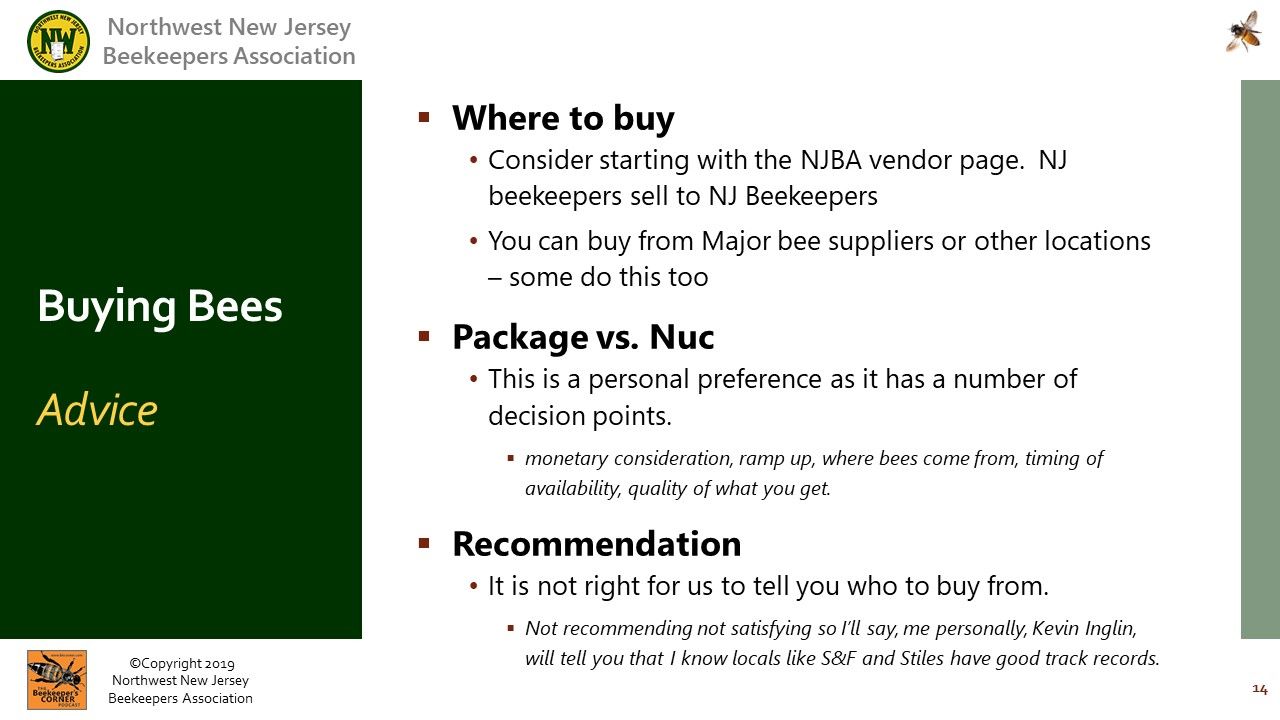
Video Timing: 17:42
: Packages are either shipped in the mail, or you pick them up.
: Nucs are either brought home in the box (box returned later) or you transfer the frames into your equipment.
: Think through the transportation of bees coming home. Likely you will have loose bees in with you but your chance of harm is very little.
: Make sure you secure bees you are transporting with all of the care you can muster.
: Install the bees as soon as you have a window to do so.
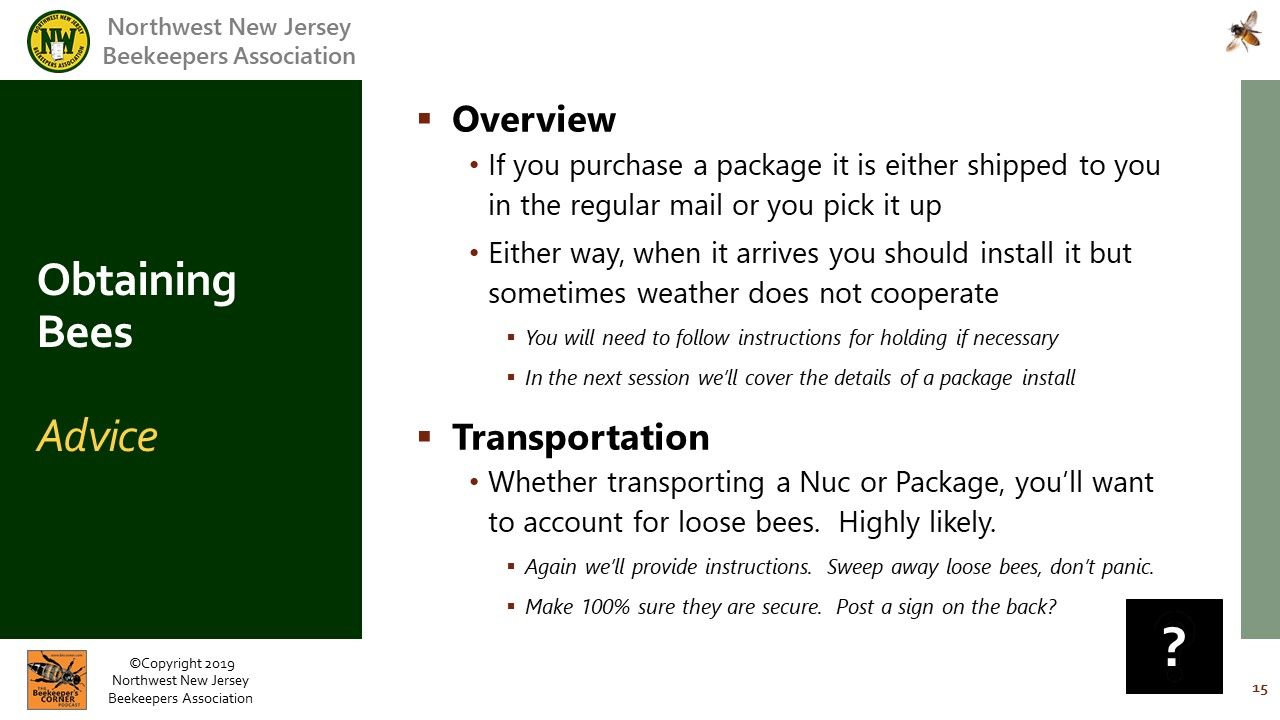
Video Timing: 22:39
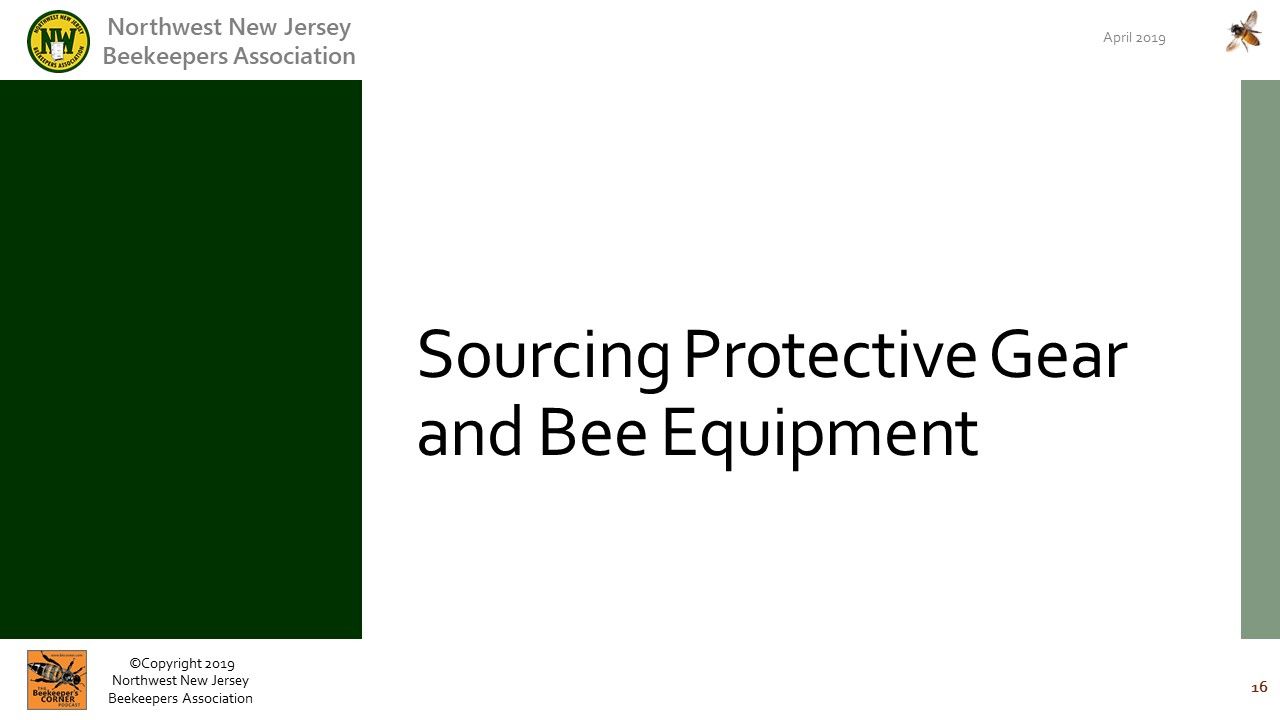
Video Timing: 22:42
: New beekeepers need to be comfortable and protected to be effective.
: If you are worried about being stung, you will rush and do it wrong, or you will avoid working bees to avoid the situation.
: Buy something that protects you and provides the ability to work bees appropriately.
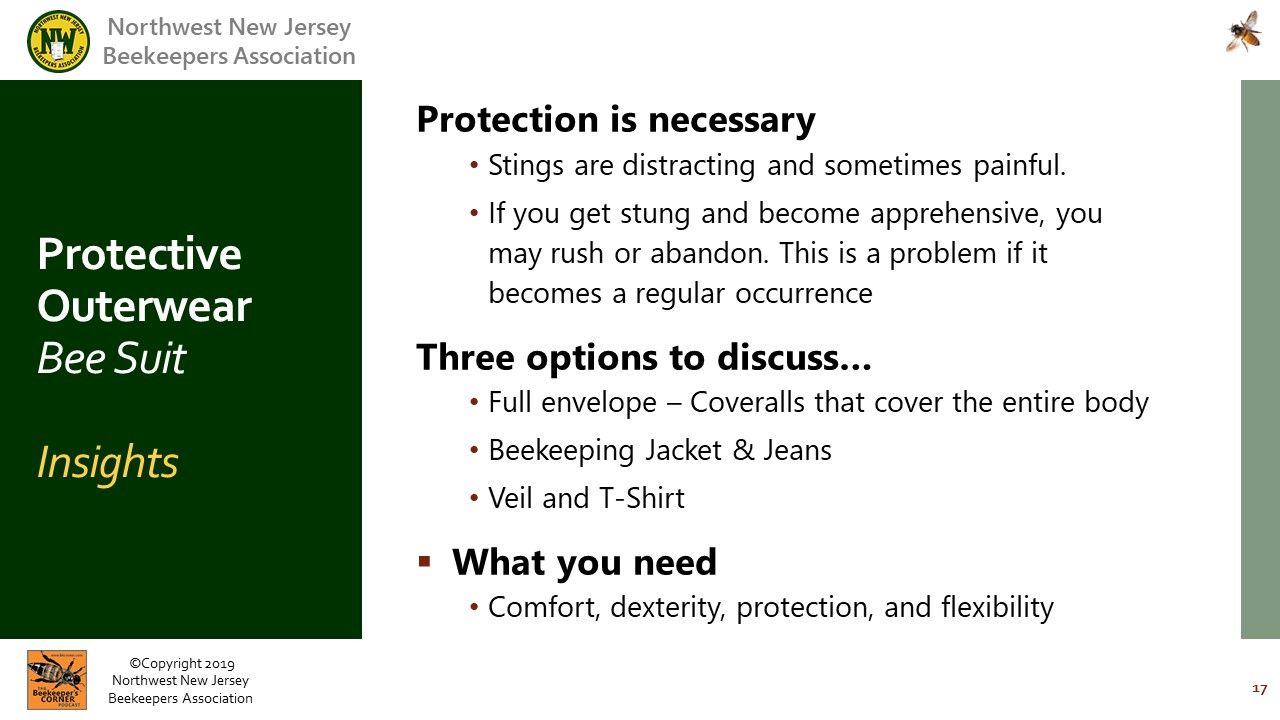
Video Timing: 23:57
: Buy coveralls or a bee jacket. Different materials afford different protection and comfort. 3-layer mesh suits are a good choice for both.
: Buy a veil for routine visits to the bee yard - those times when you are just looking.
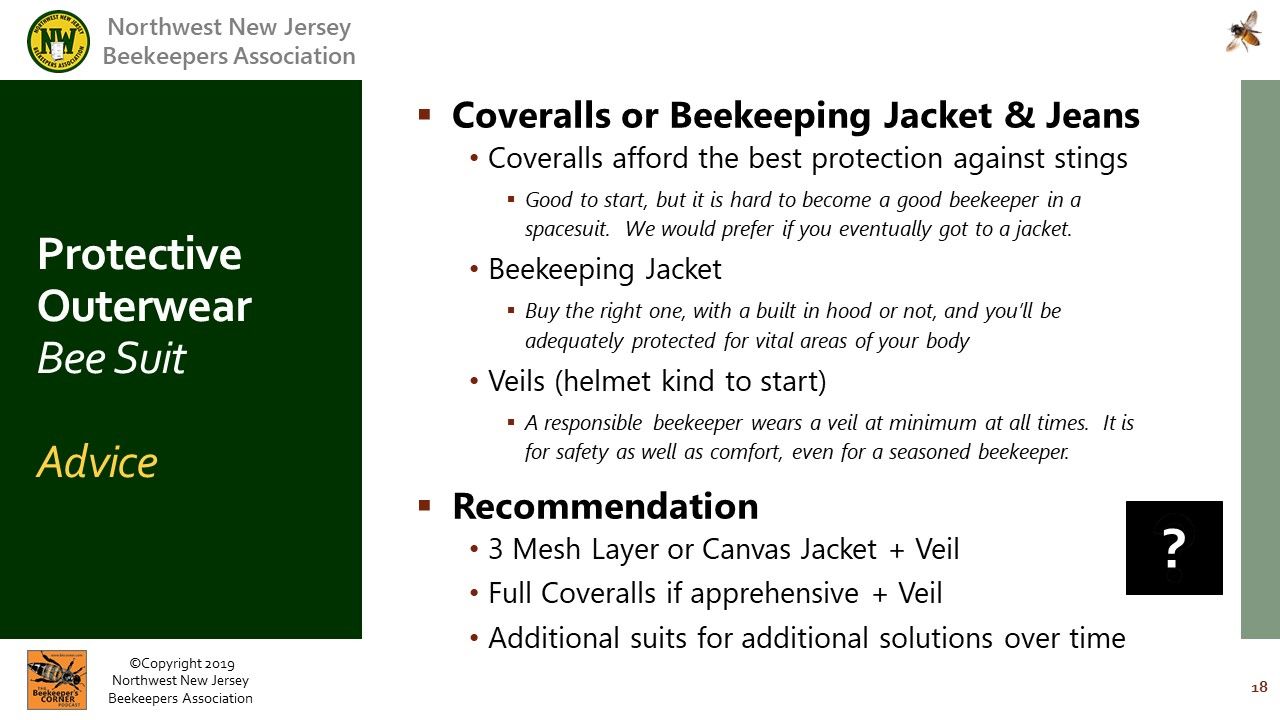
Video Timing: 30:07
: Gloves are necessary for beginners. Stings on fingers and hands can be painful.
: We recommend gloves to start but want beekeepers to work toward going gloveless
: Gloves can be clumsy, and that causes you to kill bees - which incites to alarm..
: Gloves come in many sizes and materials and you need to choose ones that you can actually work with.
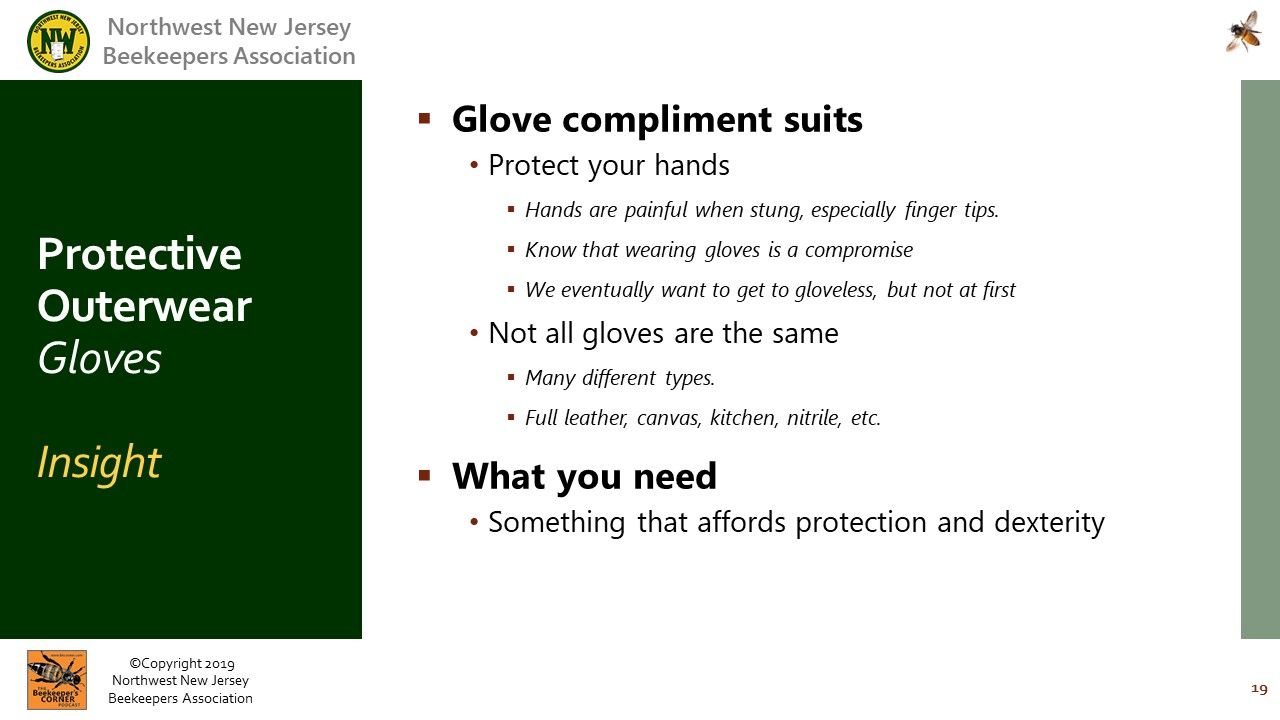
Video Timing: 34:00
: Buy gloves that are medium weight, fit well, and allow for dexterity.
: Do not buy elbow length gloves, not recommended.
: Consider supplementing work gloves with Nitrile gloves.
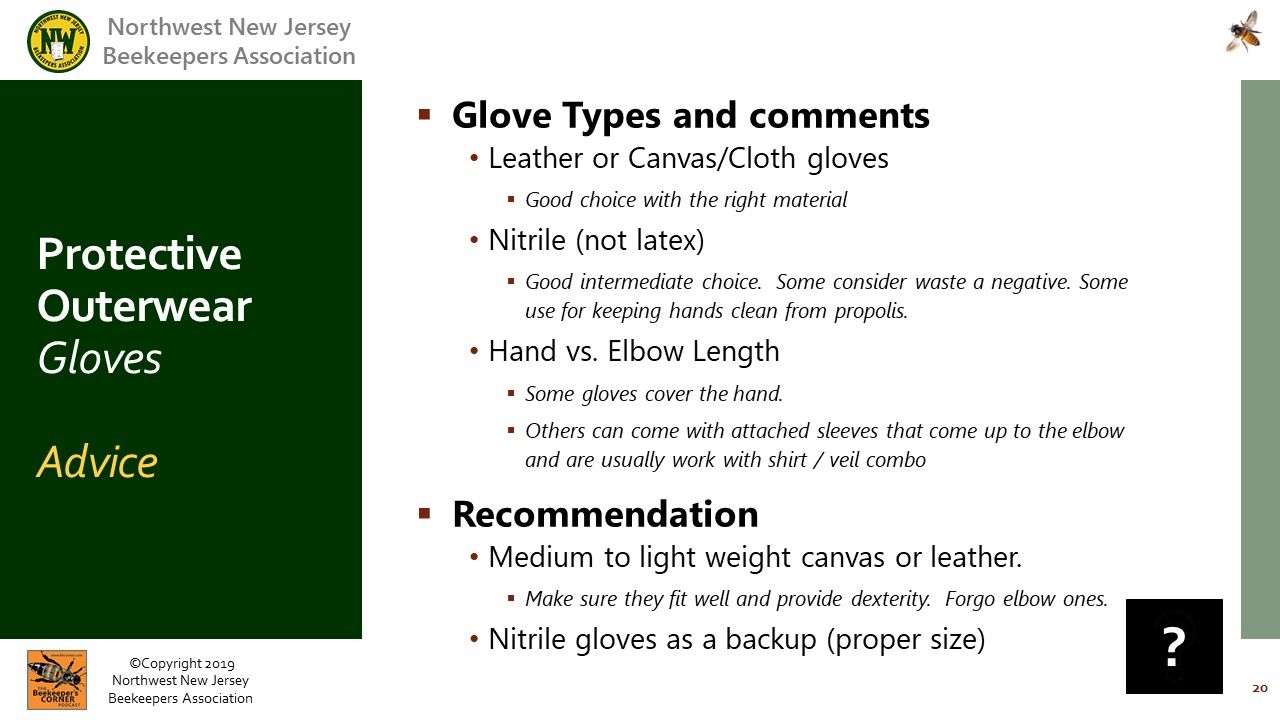
Video Timing: 34:28
: If you bought your equipment already, stay with what you have.
: Equipment is mostly standard, but differences occur.
: We do recommend that if you are buying equipment, stay with one manufacturer. Reasons are due to equipment differences, especially in frames.
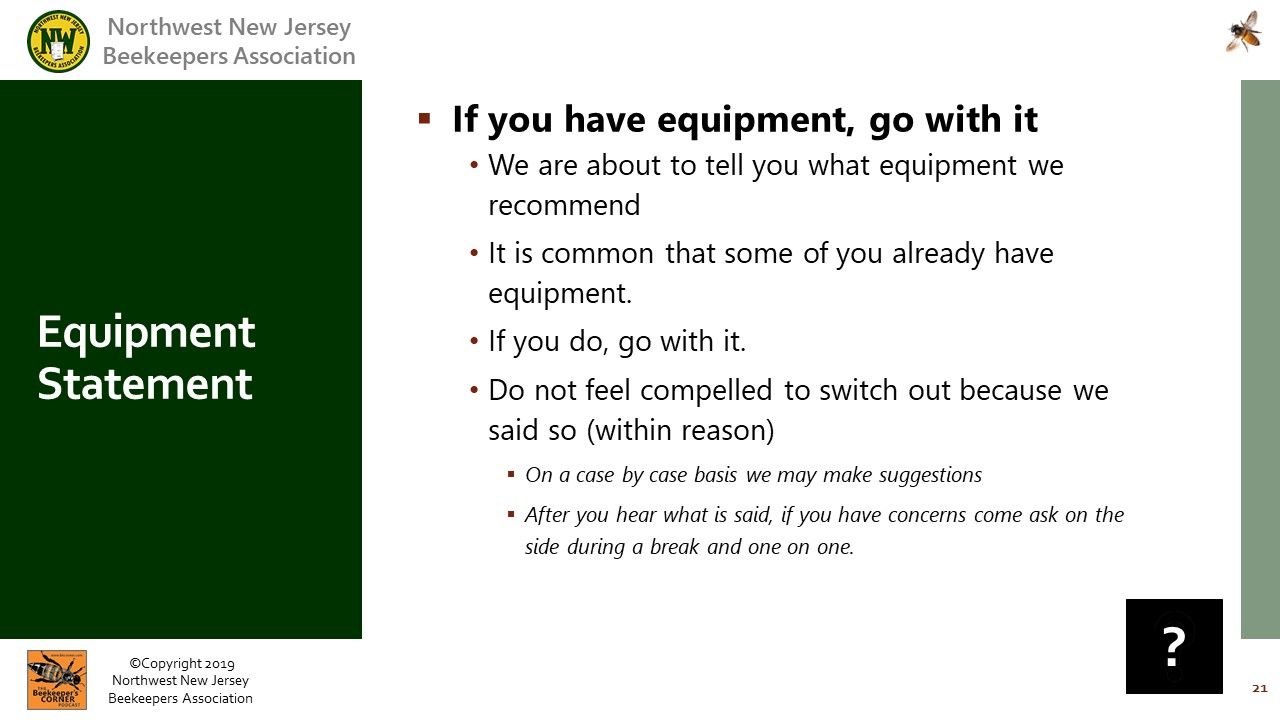
Video Timing: 35:04
: Ran through equipment needed.
; Bottom board preference is personal choice, but we prefer solid over screened for overwintering.
: We would prefer you build and use new equipment. It will be built correctly, and will be free of someone else's problems.
: Kits are ok, but sourcing your own is a right of passage and you will not end up with things you will not need.
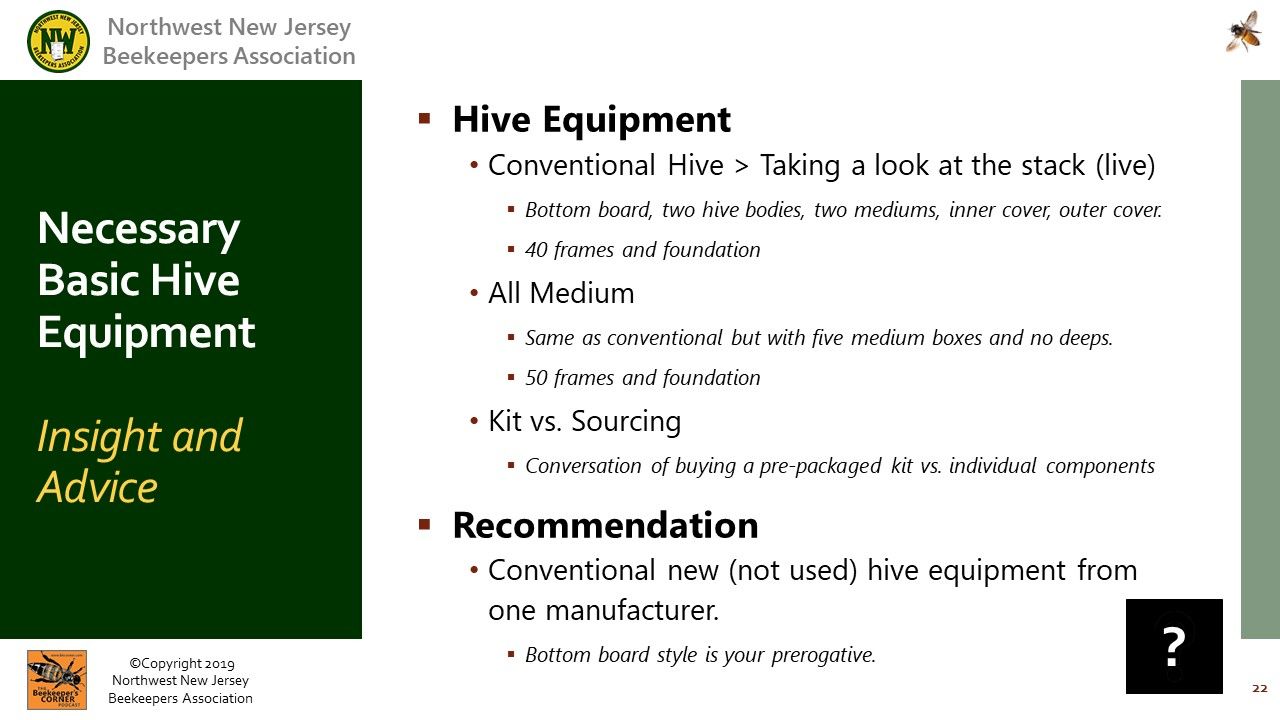
Video Timing: 45:44
: We recommend using wax foundation over plastic to start. Bees sometimes do not build out plastic very well.
: No go for foundationless for beginners in this program. Causes problems when done wrong.
: Purchase your foundation with your frames from the same manufacturer.
: Be sure you get the foundation made for the frame type you choose. Mismatches cause problems.
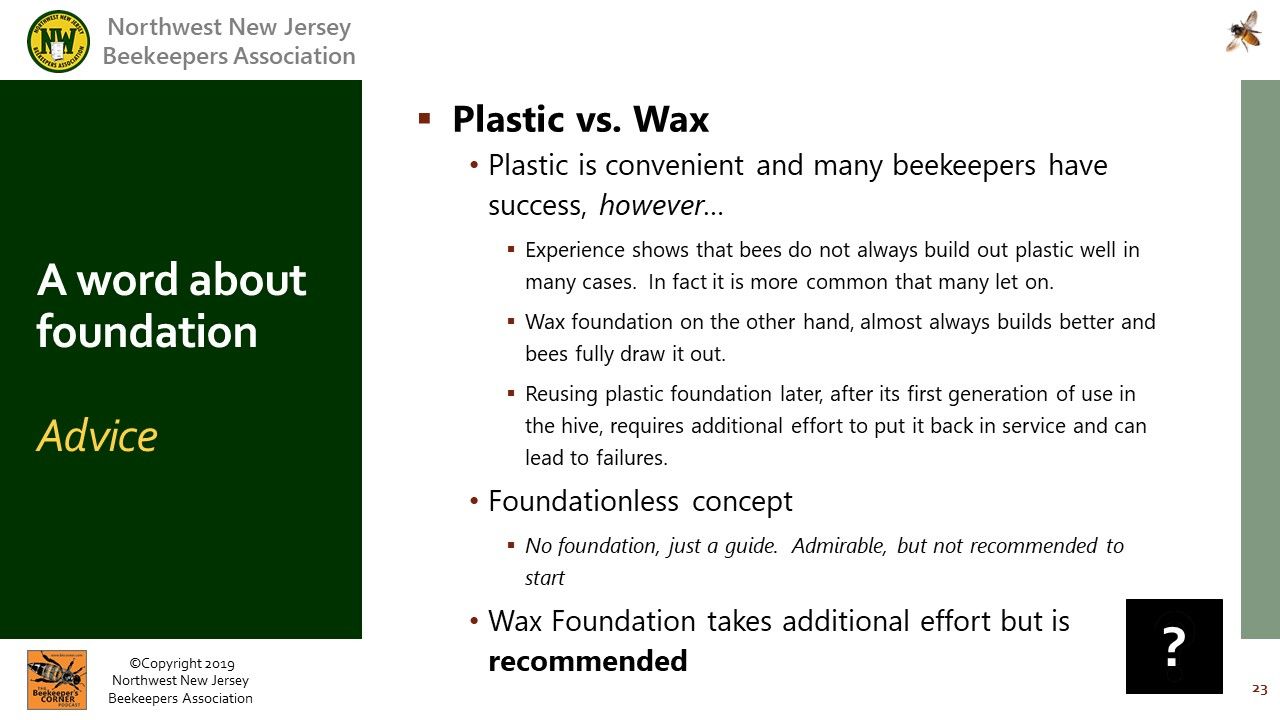
Video Timing: 55:22
Covered in this section - buying tools for your kit and necessary supplies to get started.
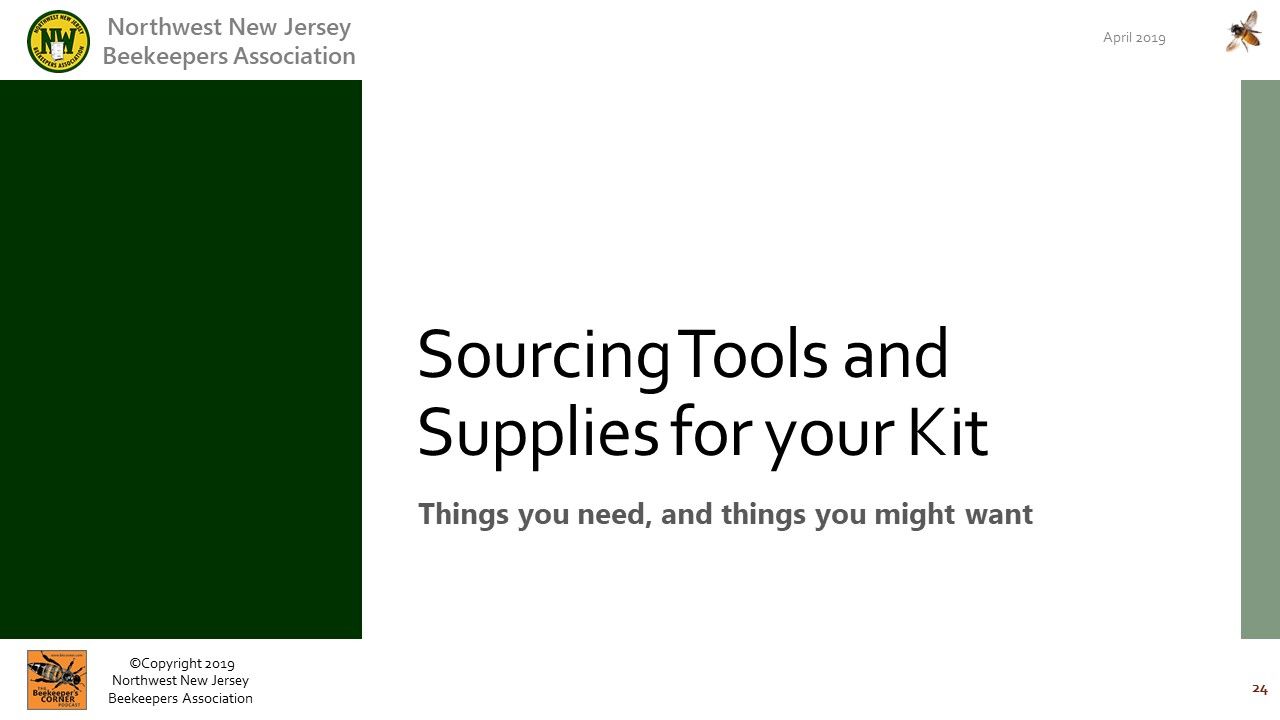
Video Timing: 55:25
: Required and recommended tools - see slide
: Do not buy a frame grip, they do not work well
: Do not need a queen excluder now, but in time we will advise on additional equipment to add to a kit.
: Buy at least a medium sized smoker so you smoker stays lit for the time required to do inspections.
: VarroaEasyCheck monitoring device is required. Available at all bee suppliers.
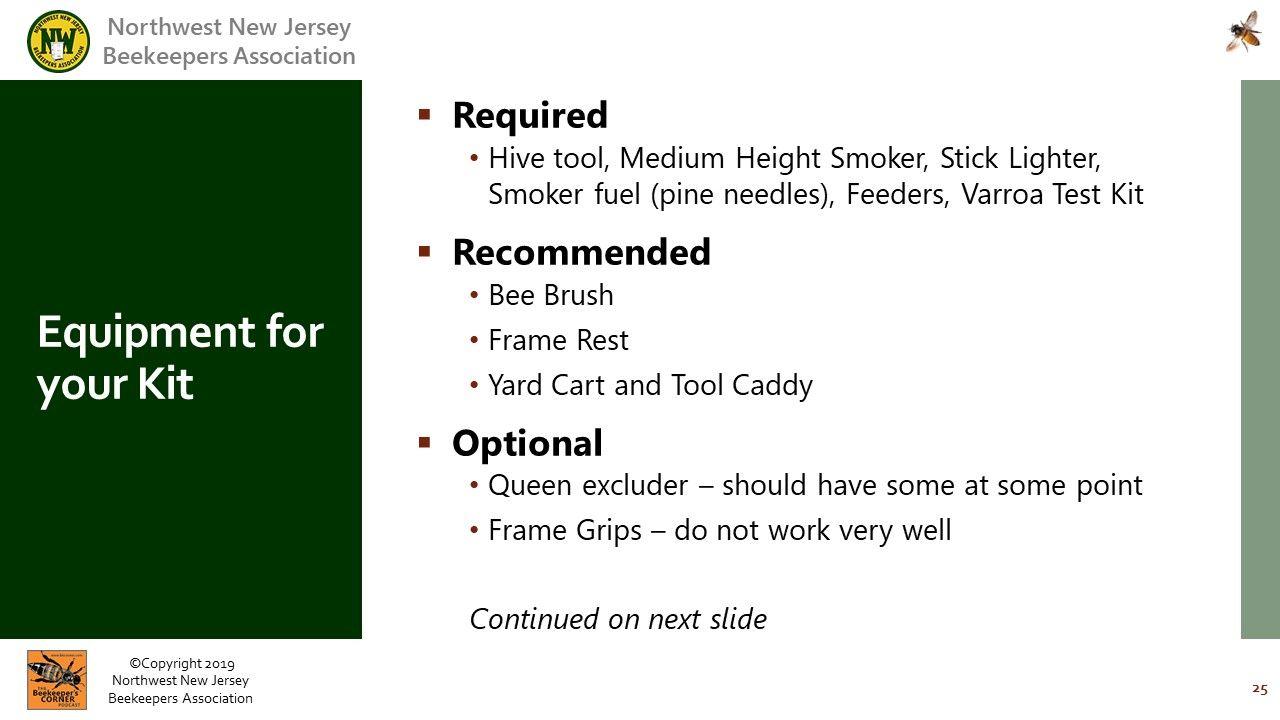
Video Timing: 59:16
: Other equipment for a kit is common and varys by beekeeper preference.
: See the kit recommendation resource below.
: Recommend epi-pen. Speak with your doctor and invest in an epi-pen. Epi-Pens require a subscription.
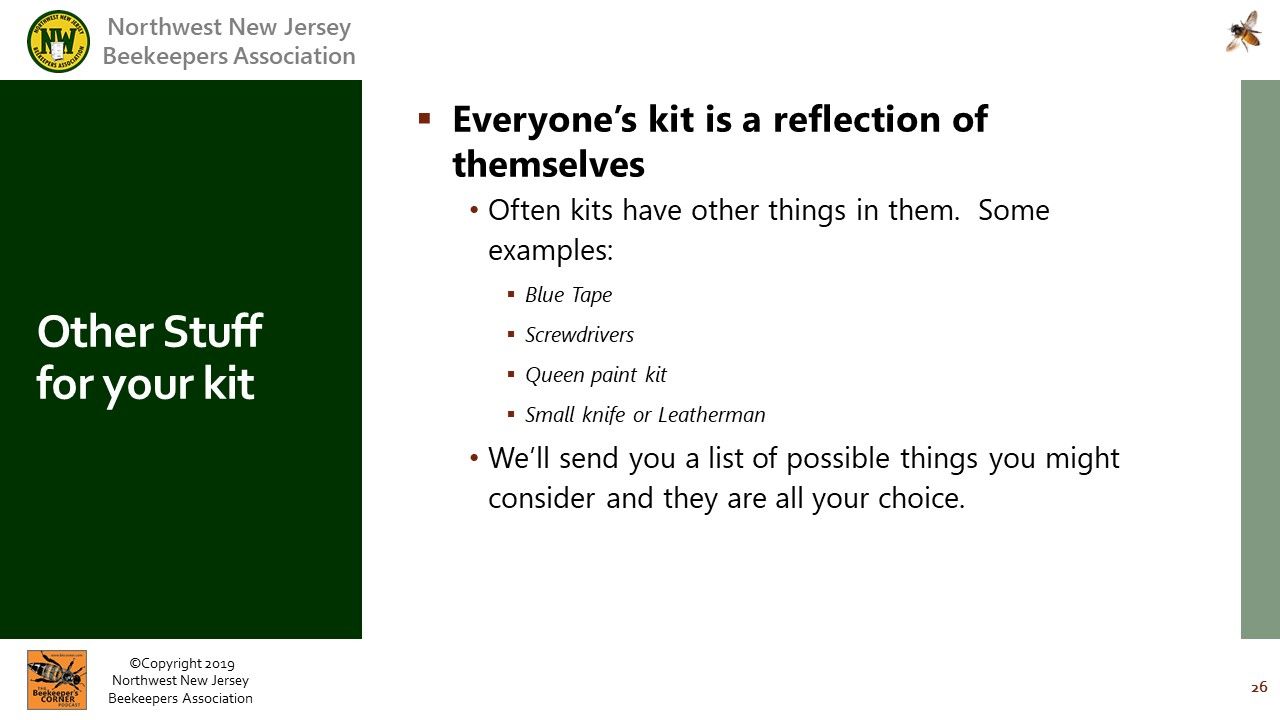
Video Timing: 60:01
: Must purchase one internal feeder, commonly referred to as a division board feeder.
: Do not purchase boardman feeders
: Will likley recommend a top feeder. Buy a Mann Lake top feeder. See the video for details.
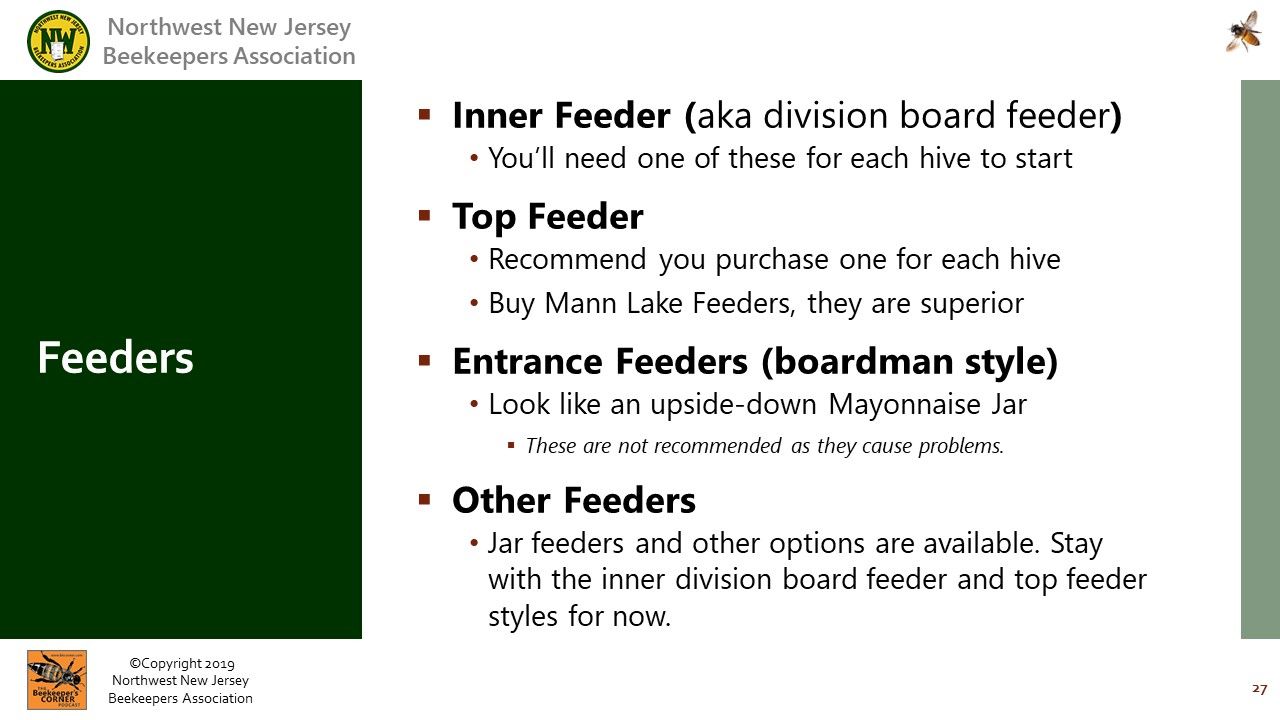
Video Timing: 65:19
: In time, and as a beekeeper, additional purchases have to be factored into your program.
: You will need equipment to manage bees and to extract honey.
: These things will be covered in time, and as the program advances.
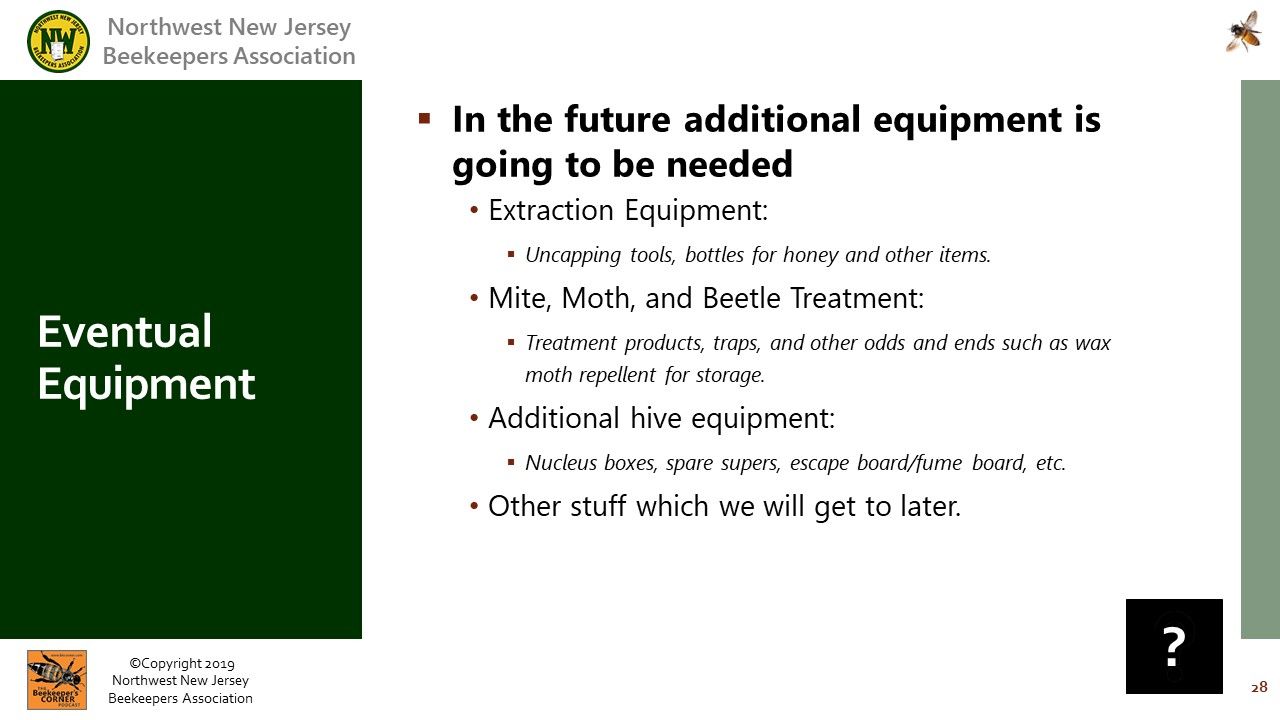
Video Timing: 66:49
Instructions for painting and assembling hive boxes, frames and more.
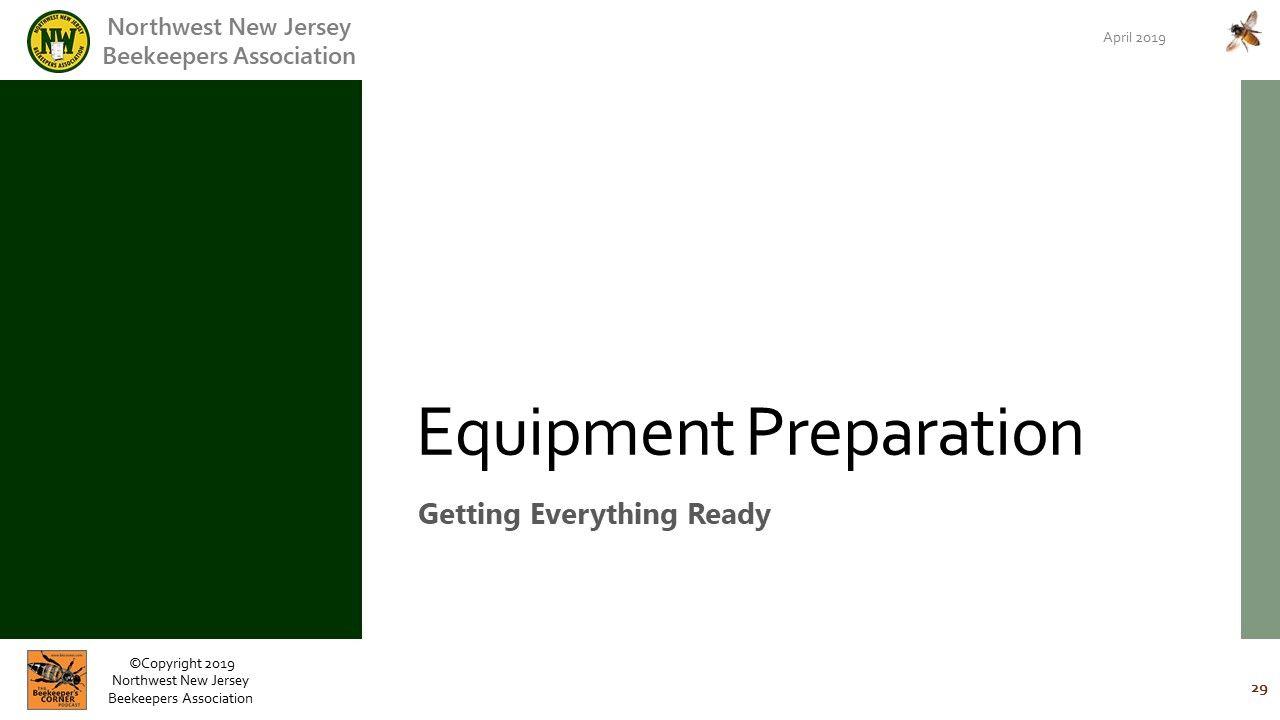
Video Timing: 14:19
Tip: For this topic, the video for this section is probably best
: Paint exterior surfaces, bottoms and tops, but not inside of hive boxes. For more detail watch the video.
: Assemble frames with a frame jig, and do not forget to properly glue and nail the top and bottom bars.
: Purchasing assembled is not a bad way to go, but a beekeeper should build their own equipment at least once to know what is required..

Video Timing: 81:40
Tip: For this topic, watching the video for this section is probably best
: Bears are in every part of NJ. Our area has some more likey bear encounter zones, especially in Warren County.
: Ratchet or Lashing straps are recommended.
: Hives require a weight on top. Bricks, patio blocks or other items required. Do not use cement block, too heavy.
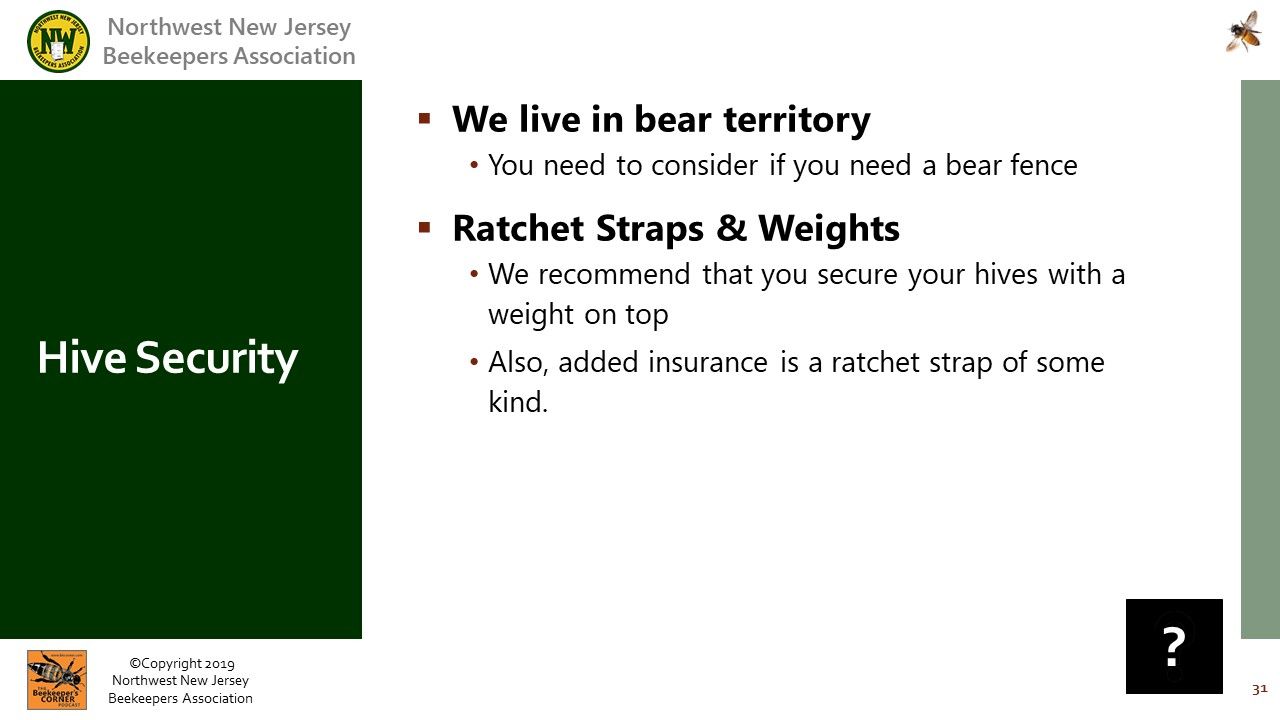
Video Timing: 82:34
How and where to place your hives
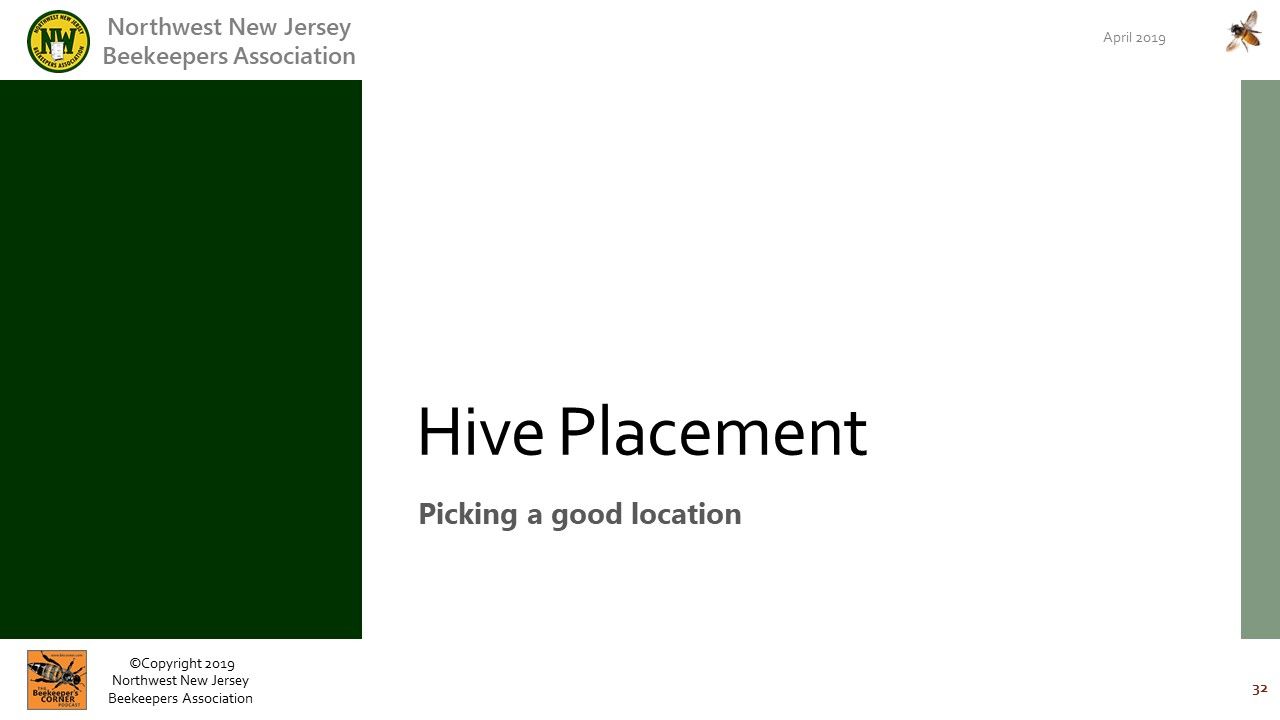
Video Timing: 82:37
Tip: For this topic, watching the video for this section is probably best
: Hives need to face the morning sun and are best in spots of full sun.
: Do not place in wet, damp, shady areas.
: Do not put your hives near things you do not want your bees to poop on. They do poop...
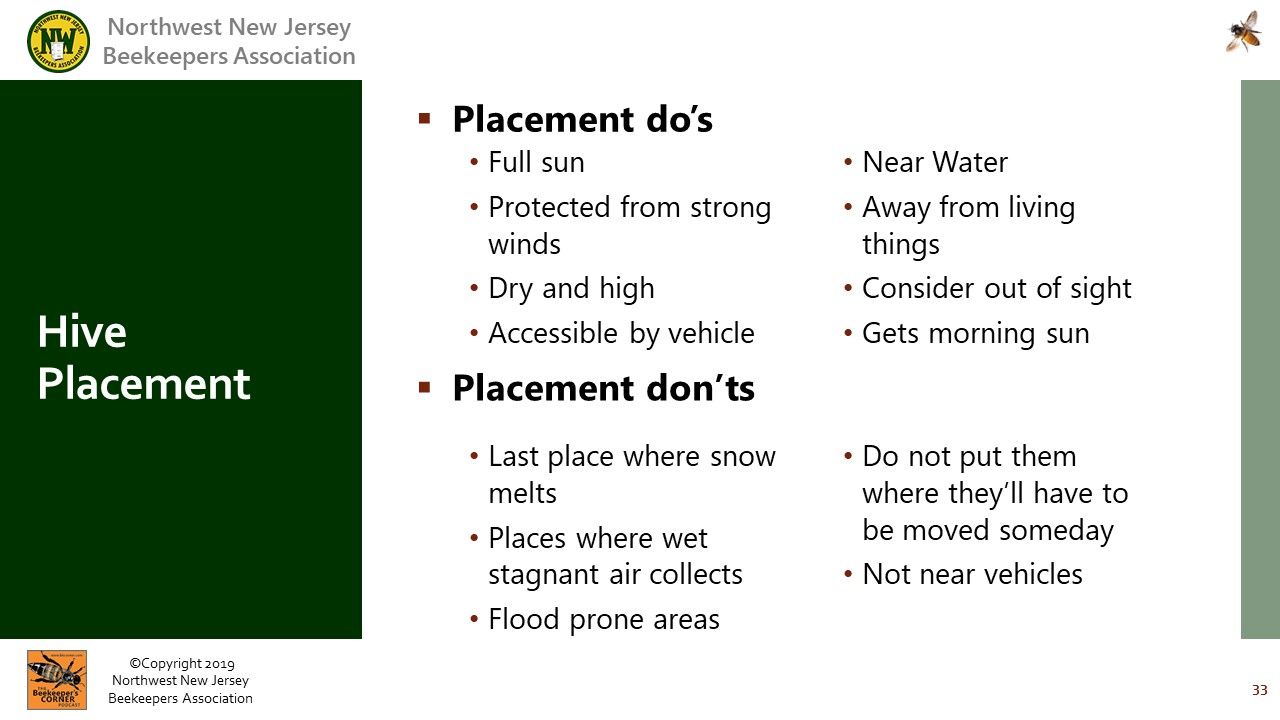
Video Timing: 87:01
Tip: For this topic, watching the video for this section is probably best
: Get hives up off the ground.
: Hives need to face the morning sun and are best in spots of full sun.
: Do not place in wet, damp, shady areas.
: We recommend you separate the hives and do not put them on a 'rail'.
: Consider something to keep the grass/weeds at bay under the hive stand.
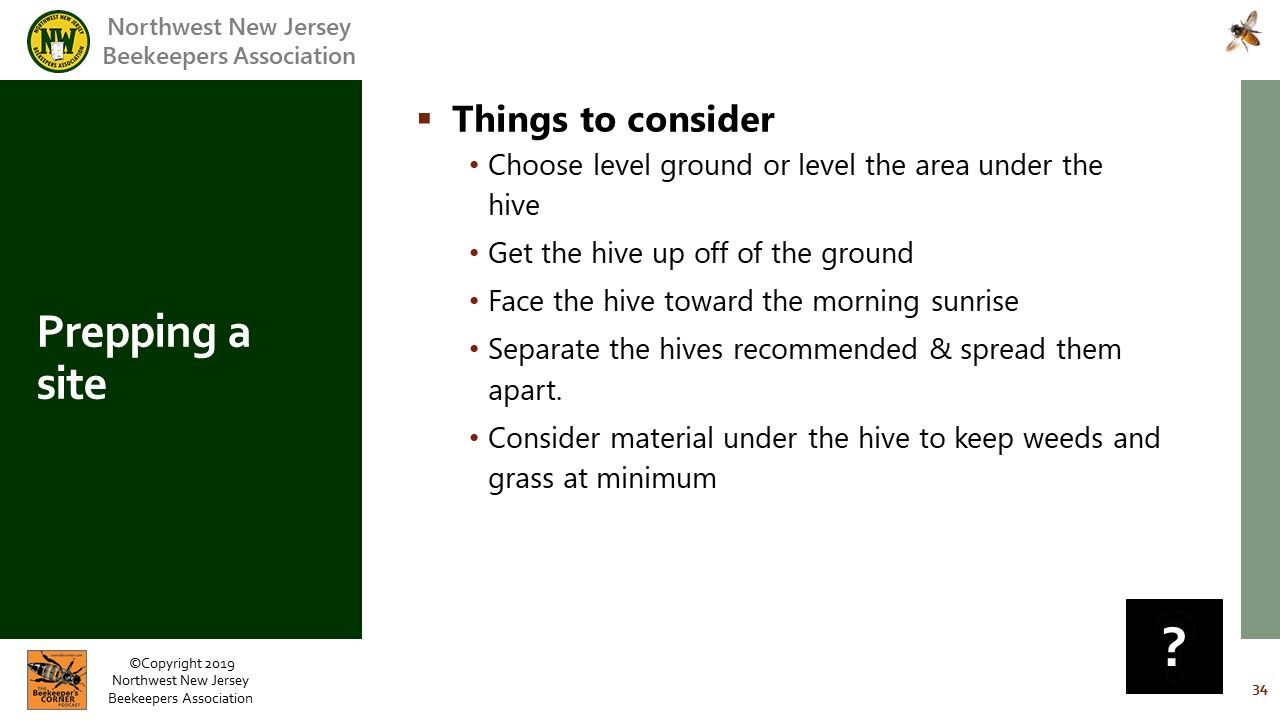
Video Timing: 93:00
Review of the future task of creating management plans and taking notes.
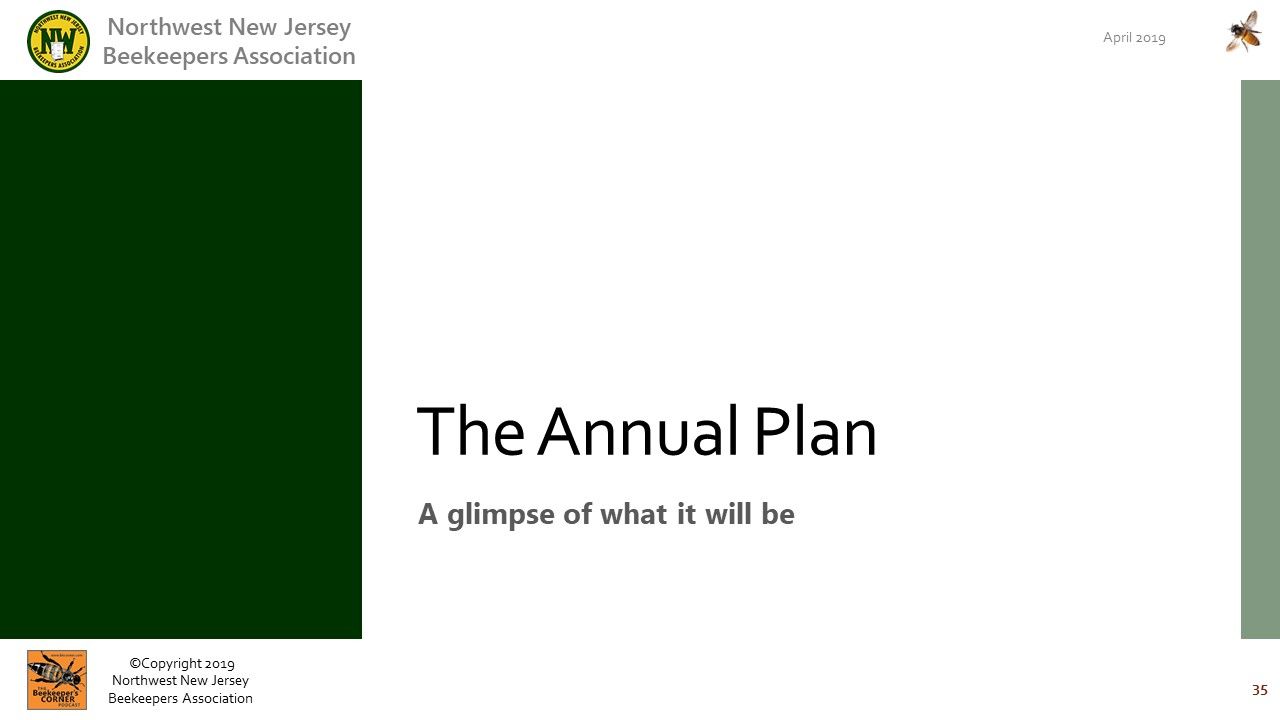
Video Timing: 93:20
: The program will provide a sample yearly plan.
: The plan will follow advice for NJ and also take advantage of the wisdom of the NJ Beekeepers Annual Calendar.
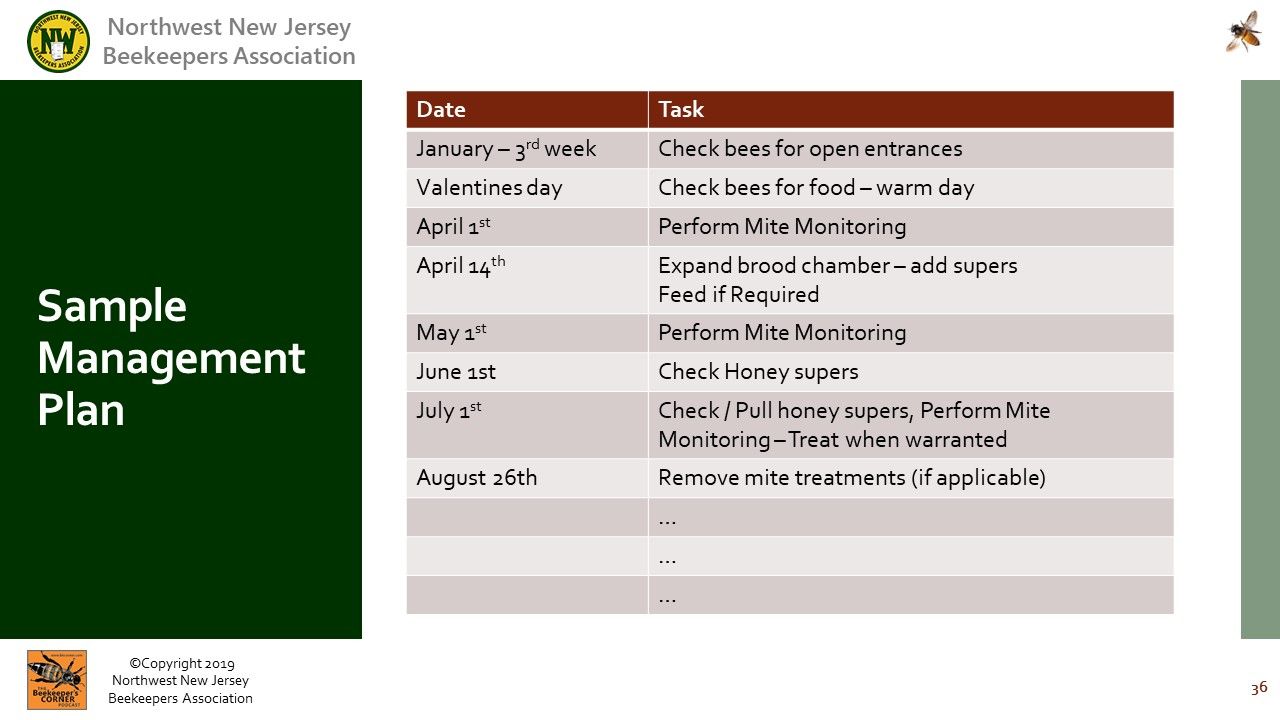
Video Timing: 93:46
: Given each beekeeper will have a different path, we will provide a template to build out a personal plan.
: A meeting will be hosted where we will break up into groups and develop individual plans that will accomodate three types
- New with package
- New with Nuc
- Second year
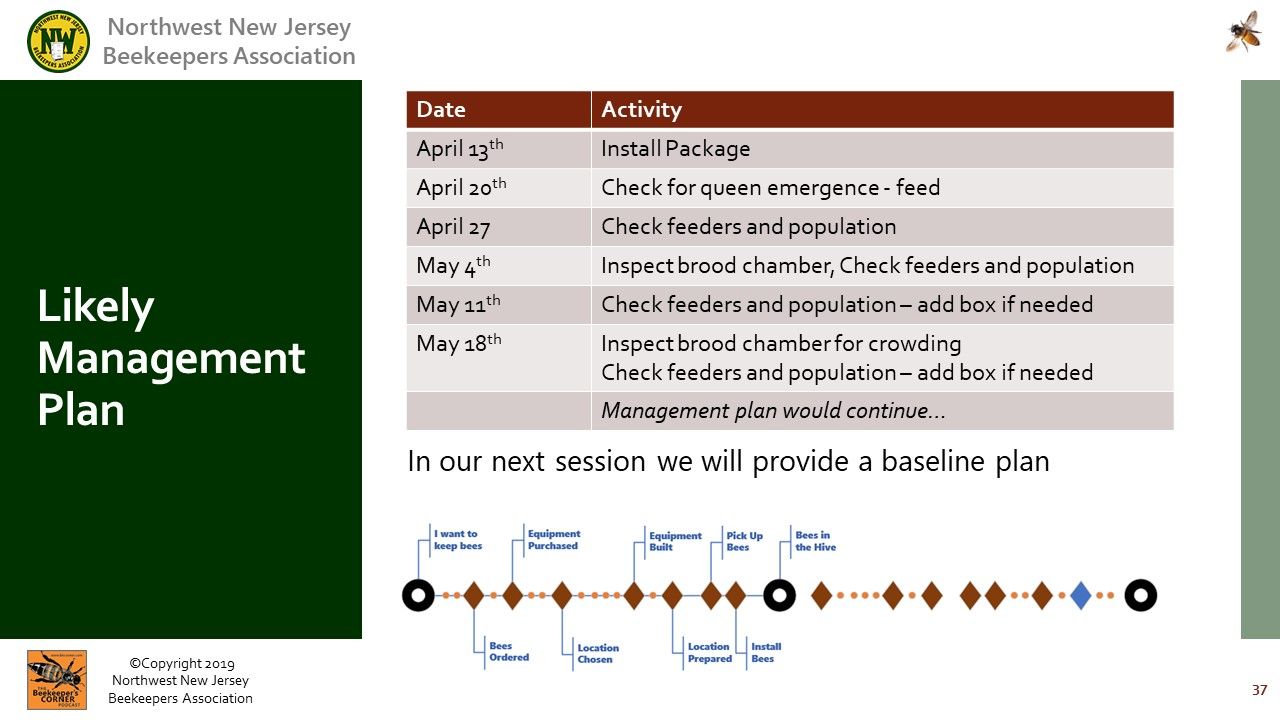
Video Timing: 94:35
: We will require beekeepers to take notes
: We will provide advice on how and more specifically what makes a good record.
: The method is personal preference.
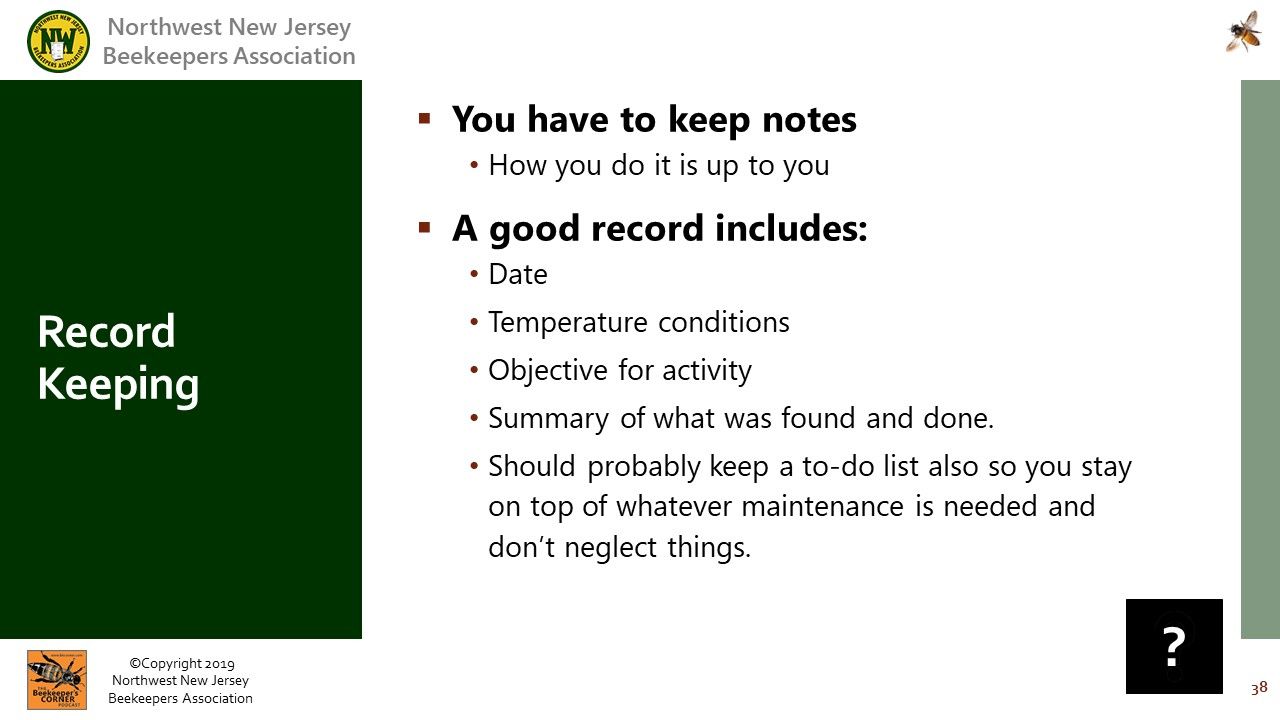
Video Timing: 95:26
Tasks to complete prior to installing bees
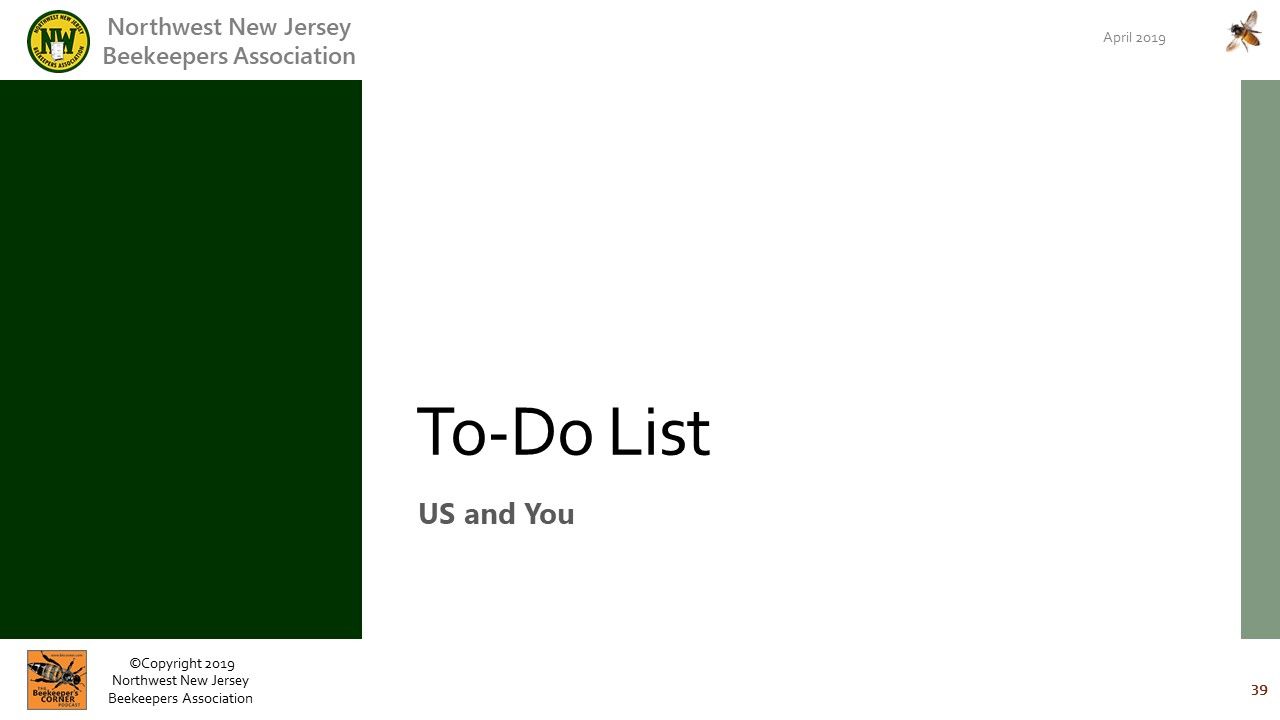
Video Timing: 95:33
: Download and get familiar with the Beekeeping Basics Guide provided by Penn State.
: Following the guidance of the presentation, get equipment, site, and tools ready.
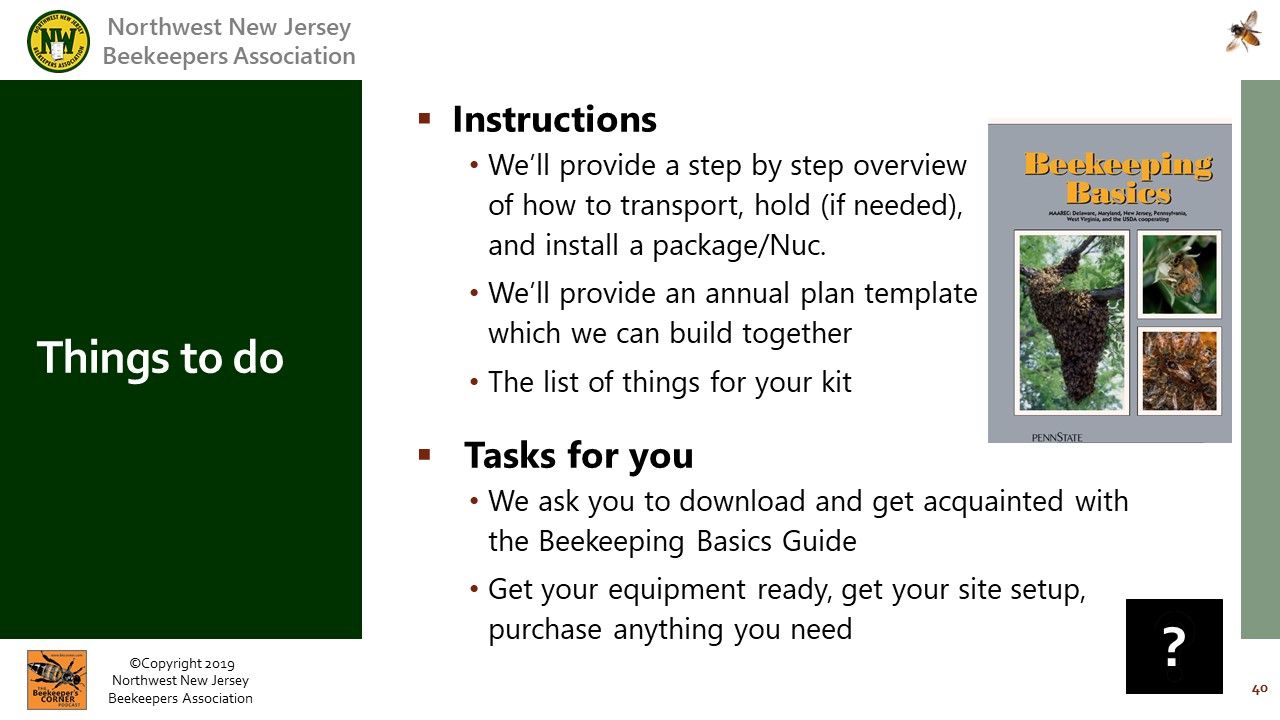
Overview of a bee package install and Nuc Placement
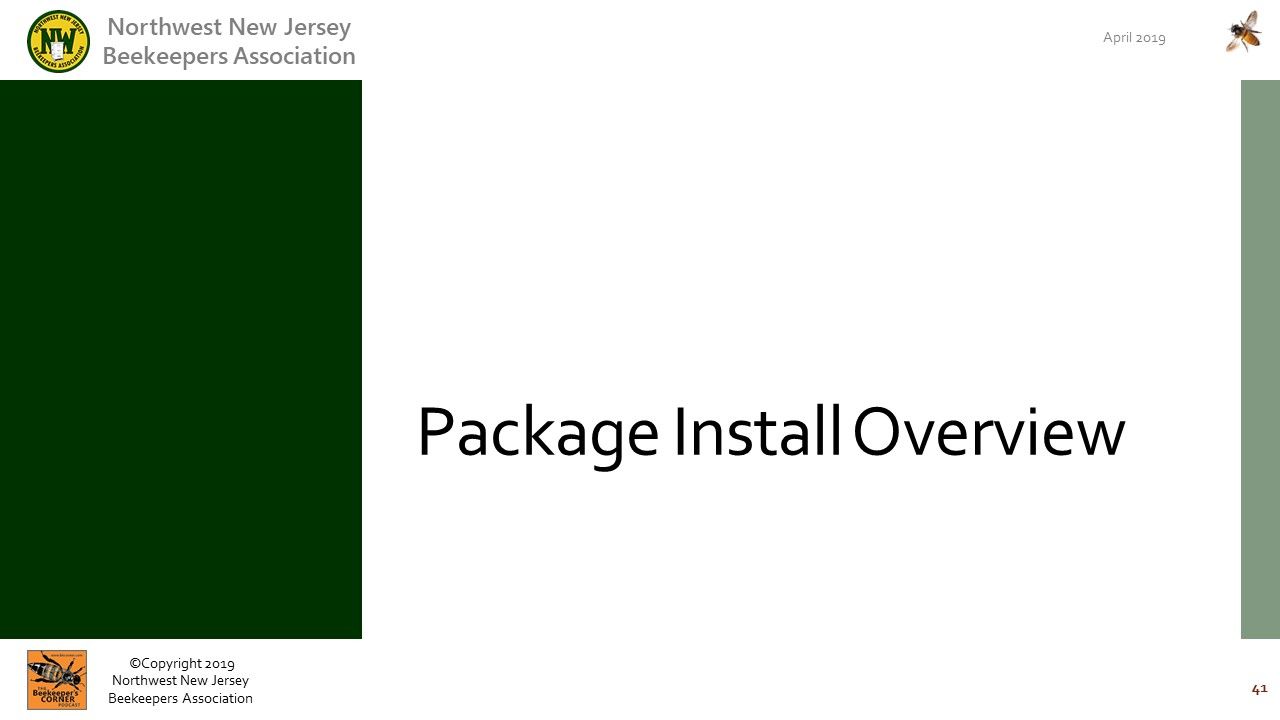
Video Timing: 97:08
: Watch the video for a walkthrough of how a package install is performed.
: Also covered fundamentals of how a Nuc is placed in a bee yard.
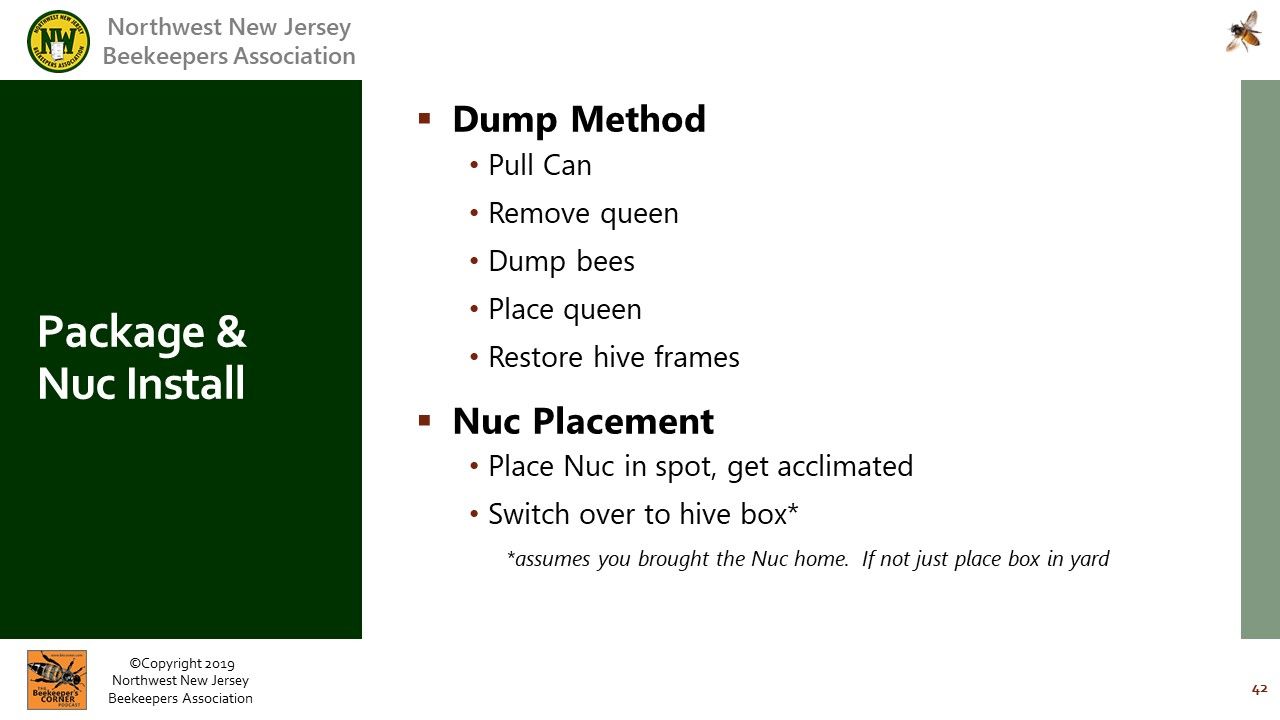
Video Timing: 102:19 - 120.00
: Answered questions from the participants. Watch the video to see what was asked the answers/comments.
Thanks for being a beekeeper.

These are resources in support of the module
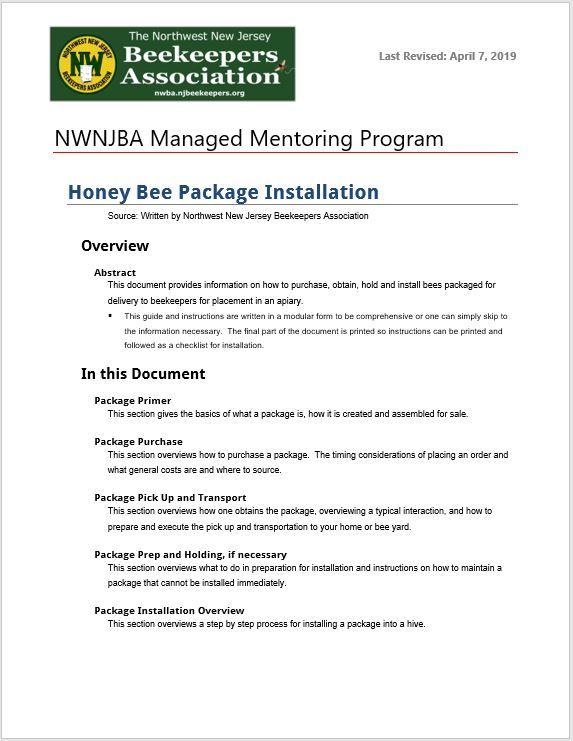
Click the button to open an comprehensive package install guide.
The guide provides prepatory steps to get ready for installation along with two versions of instructions on how to install a package. One is a step by step, fully detailed version, while the other is an outline of the steps.